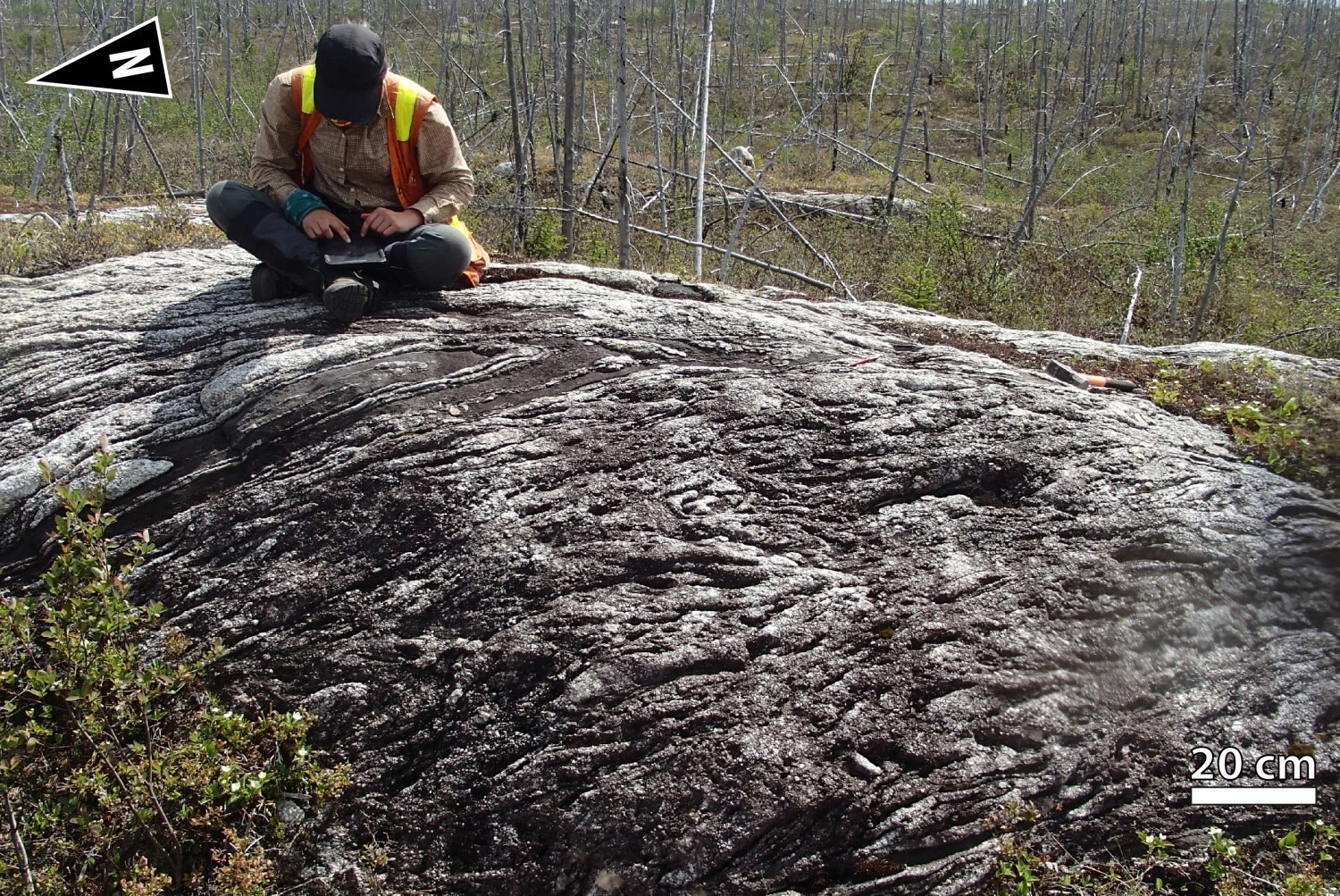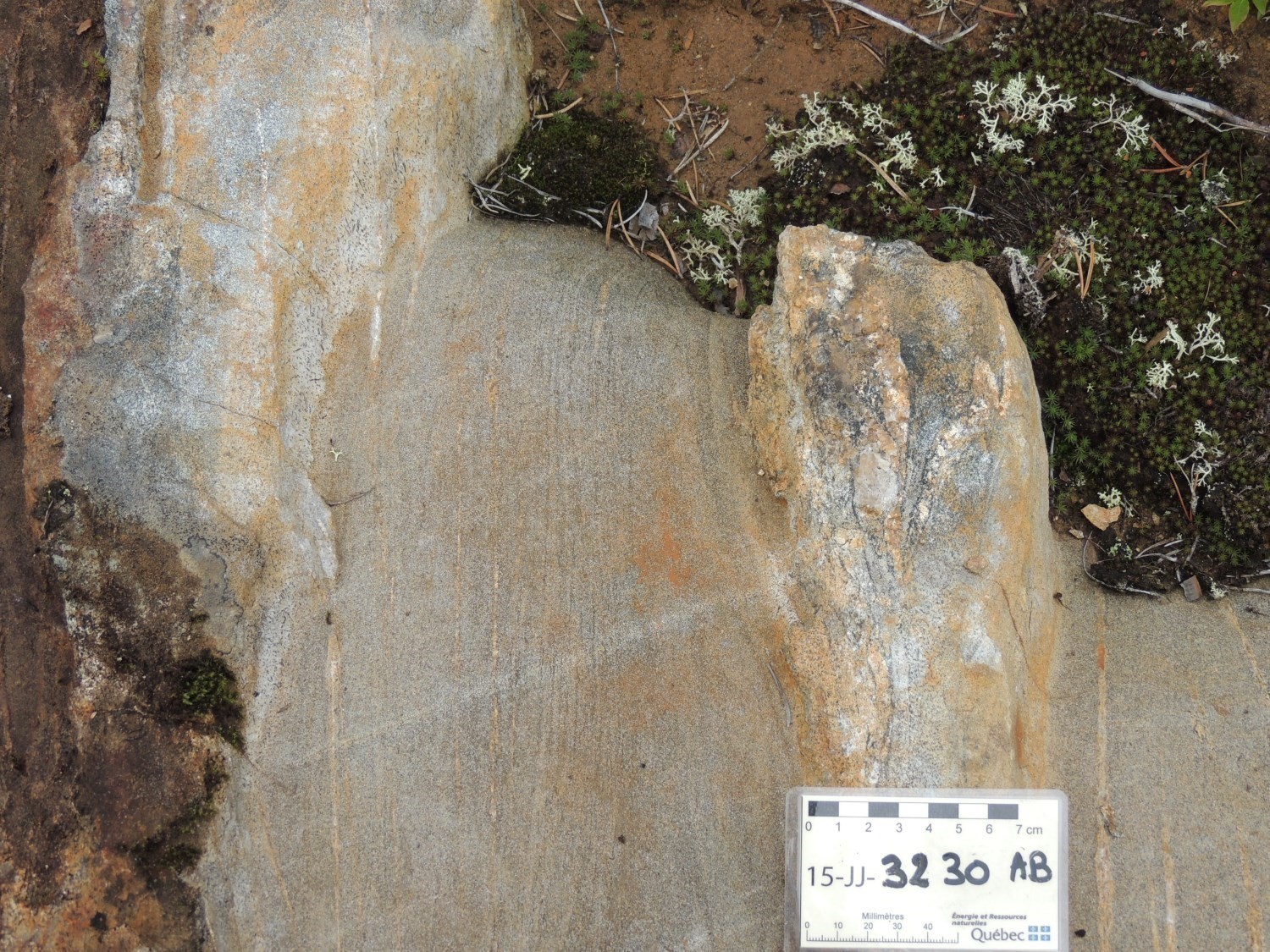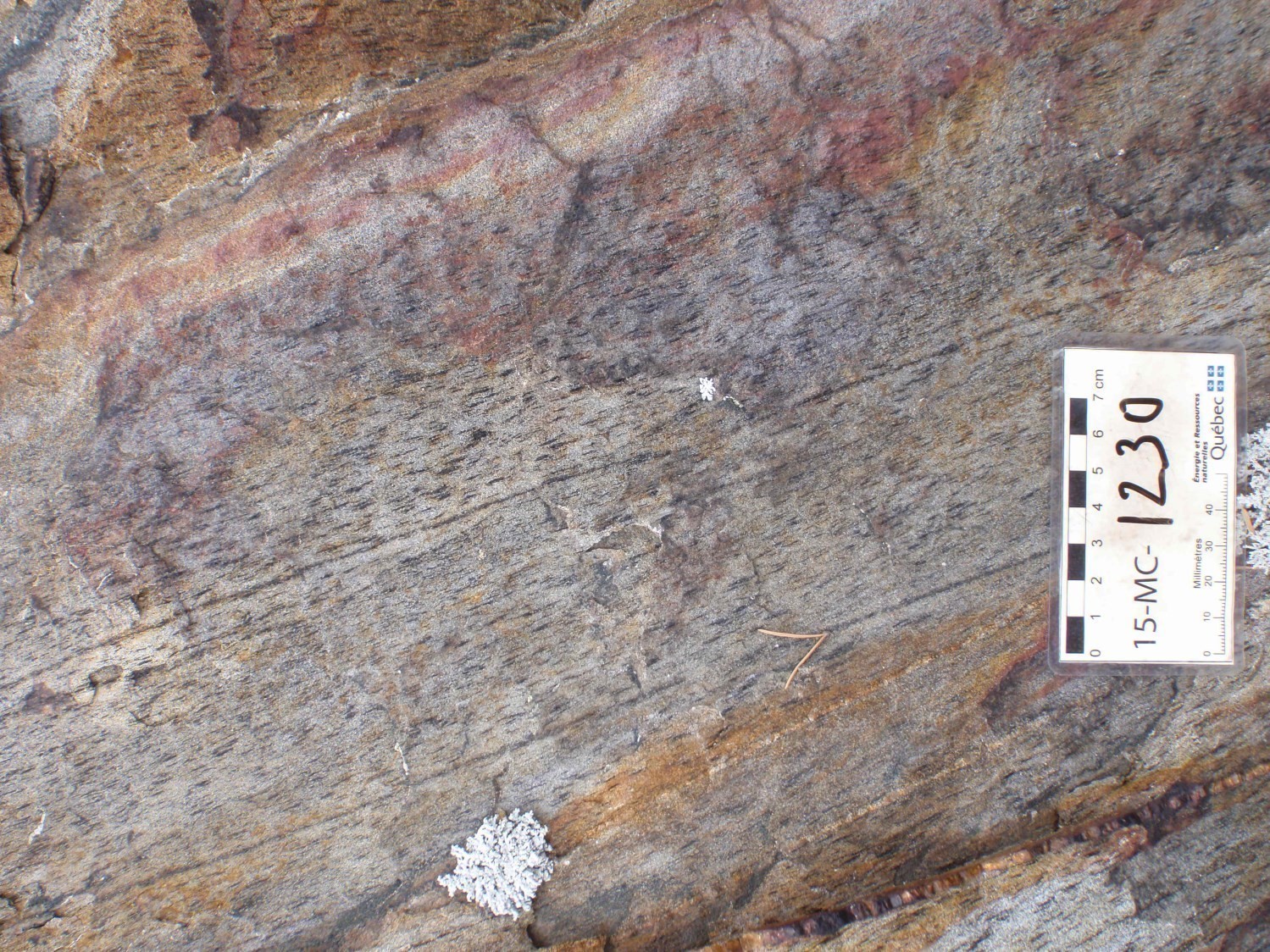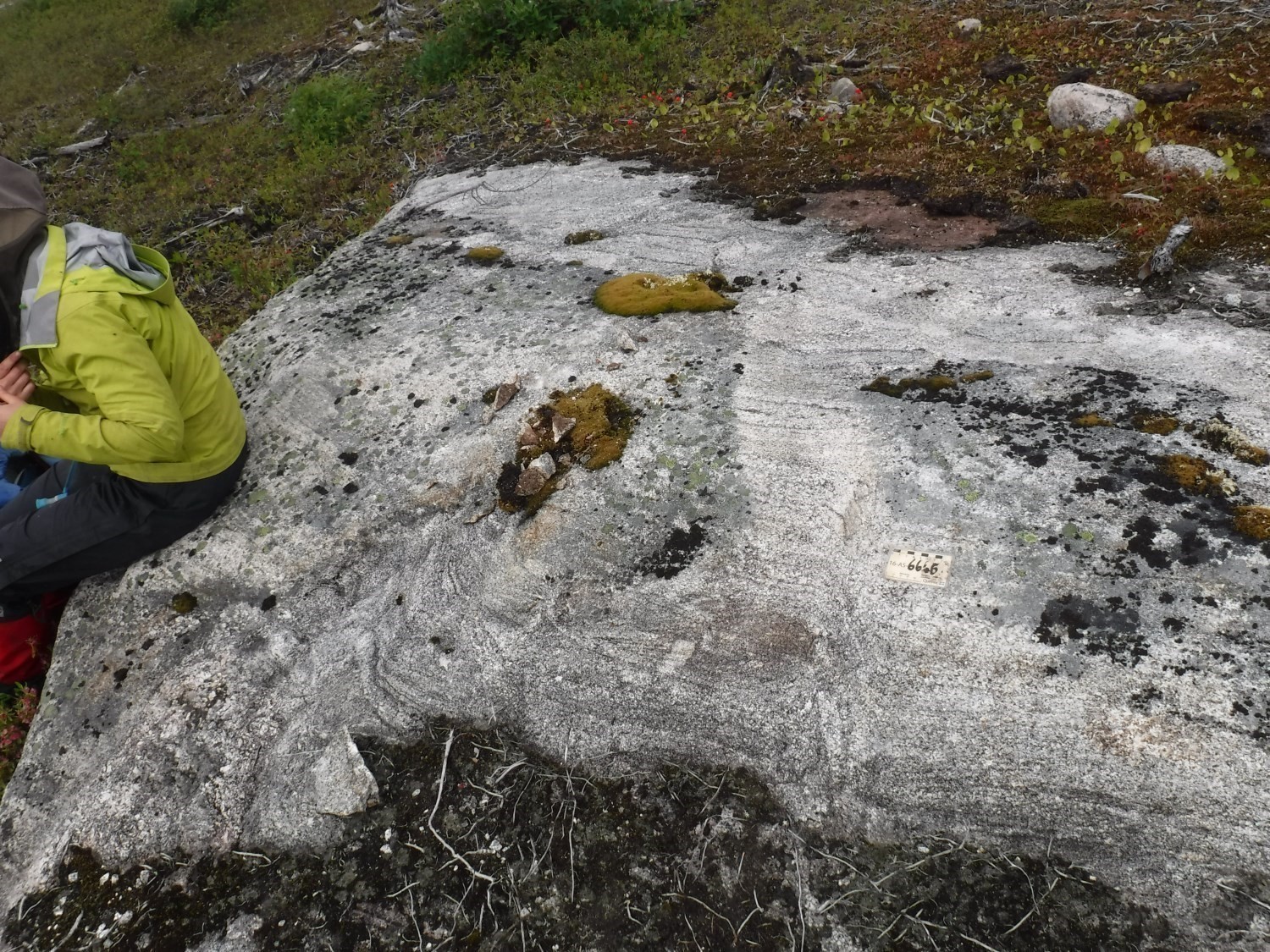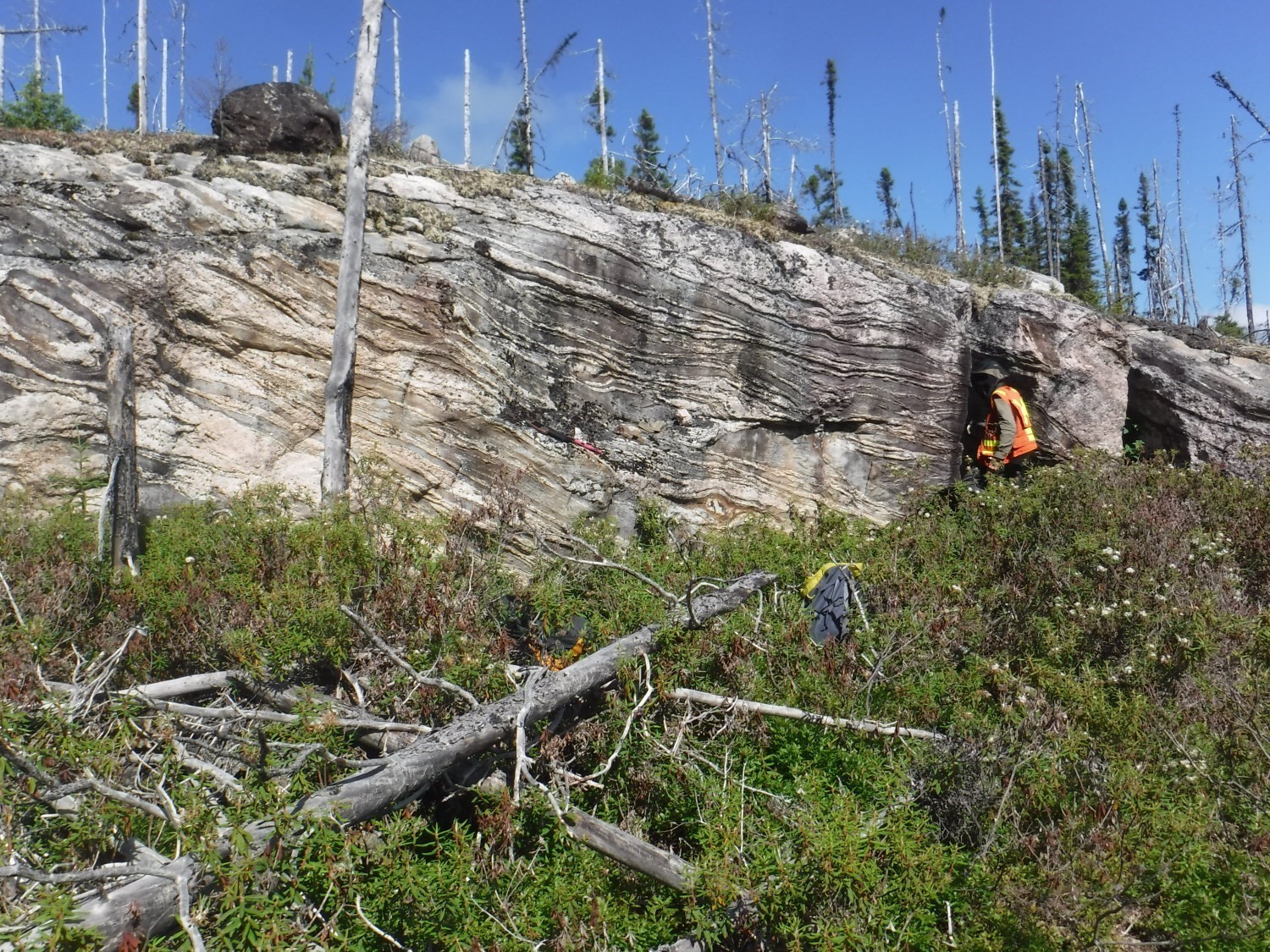
DISCLAIMER: This English version is translated from the original French. In case of any discrepancy, the French version shall prevail.
| Author(s): | Bandyayera and Fliszár, 2007 |
| Age: | Neoarchean |
| Stratotype: | None |
| Type area: | Eeyou Istchee James Bay region (NTS sheets 33A, 33B, 33C 33F, 33G, 33H, 23D, 23E and 32O) |
| Geological province: | Superior Province |
| Geological subdivision: | Opinaca Subprovince |
| Lithology: | Sedimentary, metamorphic, volcanic and intrusive rocks |
| Category: | Lithodemic |
| Rank: | Complex |
| Status: | Formal |
| Use: | Active |
None
Background
This unit was introduced by Eade et al. (1958, 1966) to define a large set of paragneisses, cut by multiple intrusions of white to pink granite and pegmatitic granite. For Lavoie et al. (1976), the “Laguiche Unit” corresponds to a gneiss of the Grande Pointe unit and its suite of granitoids. Franconi (1978) grouped migmatized metasedimentary rocks into the “Rossignol Group”. Subsequently, Fouques and Schumaker (1979) assigned the term “Laguiche Series” to the metasedimentary rocks. In order to consolidate all metasedimentary rocks in the northern part of the Opinaca Subprovince, Gauthier et al. (1997) introduced the term “Rossignol-Laguiche Group”. This name was simplified to “Laguiche Group” by Simard and Gosselin (1999) and Goutier et al. (2000). More recently, Bandyayera and Fliszár (2007) defined the Laguiche Complex (nAlgi) to include all the migmatized paragneisses of the Opinaca Subprovince.
The following table lists the different names and equivalencies of the units of the Laguiche Complex over time and their first mention in a Ministère‘s report.
| Actual Units | Franconi (1978) | Simard and Gosselin (1999) | Fallara et al. (1999) | Goutier et al. (1999) | Goutier et al. (2000) | Goutier et al. (2001, 2002) | Bandyayera et al. (2007) | Bandyayera et al. (2010) | Goutier et al. (2011 to 2017) | Talla Takam et al. (in preparation) | Beauchamp (2020) |
| nAlgi1 | Alu | Algi1 | nAlgi1 | ||||||||
| nAlgi2a | Alu | Alu | Algi2 | Algi2a | nAlgi2a | ||||||
| nAlgi2b | Alu2 | Alu2 | Algi2b | nAlgi2b | |||||||
| nAlgi2c | nAlgi2c | ||||||||||
| nAlgi3a | Alu | Alu | Algi3a | nAlgi3a | |||||||
| nAlgie3b | Alu2 | Alu2 | Algi3b | nAlgi3b | |||||||
| nAlgi4 | Algi4 | nAlgi4 | |||||||||
| nAlgi4a | Alu | Alu | Algi4a | nAlgi4a | |||||||
| nAlgi4b | nAlgi4b | ||||||||||
| nAlgi5 | Alu5 | Alu5 | nAlgi5 | ||||||||
| nAlgi6 | Felsic tuff of the Yasinski Group | Alu6 | nAlgi6 | ||||||||
| nAlgi7 | Alu1 | Alu1 | nAlgi7 | ||||||||
| nAlgi8 | nAlgi8 | ||||||||||
| nAlgi9 | Alu 4 (iron formation) | nAlgi9 | |||||||||
| nAlgi10 | Alu1 | Alu1 | nAlgi10 | ||||||||
| nAlgi11 | Gorge Prosper Gneiss | Alu3 | Alu3 | nAlgi11 | |||||||
| nAlgi12 | Alu1 | nAlgi12 | |||||||||
| nAlgi13 | Alu4 | nAlgi13 | |||||||||
| nAlgi14 | nAlgi14 |
Description
The Laguiche Complex is a metasedimentary unit composed mainly of paragneiss, metatexite and diatexite. This unit consists mainly of biotite paragneisses derived from the gradual transformation of feldspathic wacke and mudrock. A few arkosic arenite beds were also observed in sheet 33F07. Minor lithologies of this unit are felsic tuff, iron formation interstratified with metasedimentary rocks and polymictic conglomerate. The Laguiche Complex contains rare iron formations interstratified with metasedimentary rocks. The mobilisate is generally granitic in composition, but may vary from tonalitic to granodioritic. That being said, a stain analysis does not provide sufficiently representative results to estimate the percentage of granitic or tonalitic mobilisate, and even less to provide a possible geographical distribution of mobilisate composition.
The paragneiss located in the Opinaca Subprovince may be confused with those of the Rivière Salomon Formation in the La Grande Subprovince. However, Laguiche Complex paragneisses may contain orthopyroxene, unlike those of the Rivière Salomon Formation. Moreover, the granoblastic texture is less developed in the Rivière Salomon Formation because of a weaker recrystallization. Finally, protoliths of the Laguiche Complex paragneisses are only arkosic, whereas they can be quartz-rich or arkosic in the Rivière Salomon Formation.
Units nAlgi2a, nAlgi3a and nAlgi4a are defined based on the percentage of mobilisate observed on outcrops: 1) <10% mobilisate, paragneiss derived from wacke (nAlgi2a); 2) 10 to 50%, paragneiss metatexite (nAlgi3a); and 3) >50%, paragneiss diatexite (nAlgi4a) (Gigon and Goutier, 2016). These percentages are valid for the northern part of the Laguiche Complex (sheets 33F, 33G, 33H and 23E), while the SW part is mainly based on a maximum of 20% mobilisate for units nAlgi2a and nAlgi2b, and a 20 to 50% mobilisate interval for units nAlgi3a and nAlgi3b (Bandyayera and Lacoste, 2009; Bandyayera et al., 2010).
Units nAlgi12 and nAlgi13 were derived from field studies conducted in 1997 by Simard and Gosselin (1999); the knowledge of the area has not changed since.
Laguiche Complex 1 (nAlgi1): Amphibolite of Volcanic Origin, Locally Pillowed
Following compilation work in 2021, the description of unit nAlgi1 has been changed from « Amphibolite, iron formation, mafic gneiss and locally metabasalt » to « Amphibolite of volcanic origin, locally pillowed », to better differentiate the amphibolite of unit nAlgi1 of volcanic origin from the amphibolite of unit nAlgi5, which are more plutonic in origin.
Unit nAlgi1 consists mainly of banded amphibolite, identifiable in places as pillow metabasalt. Locally, iron formations and mafic gneissre found in unit nAlgi1. In sheets 33B13 and 23D14, the polygons on the map were mostly drawn by following magnetic highs.
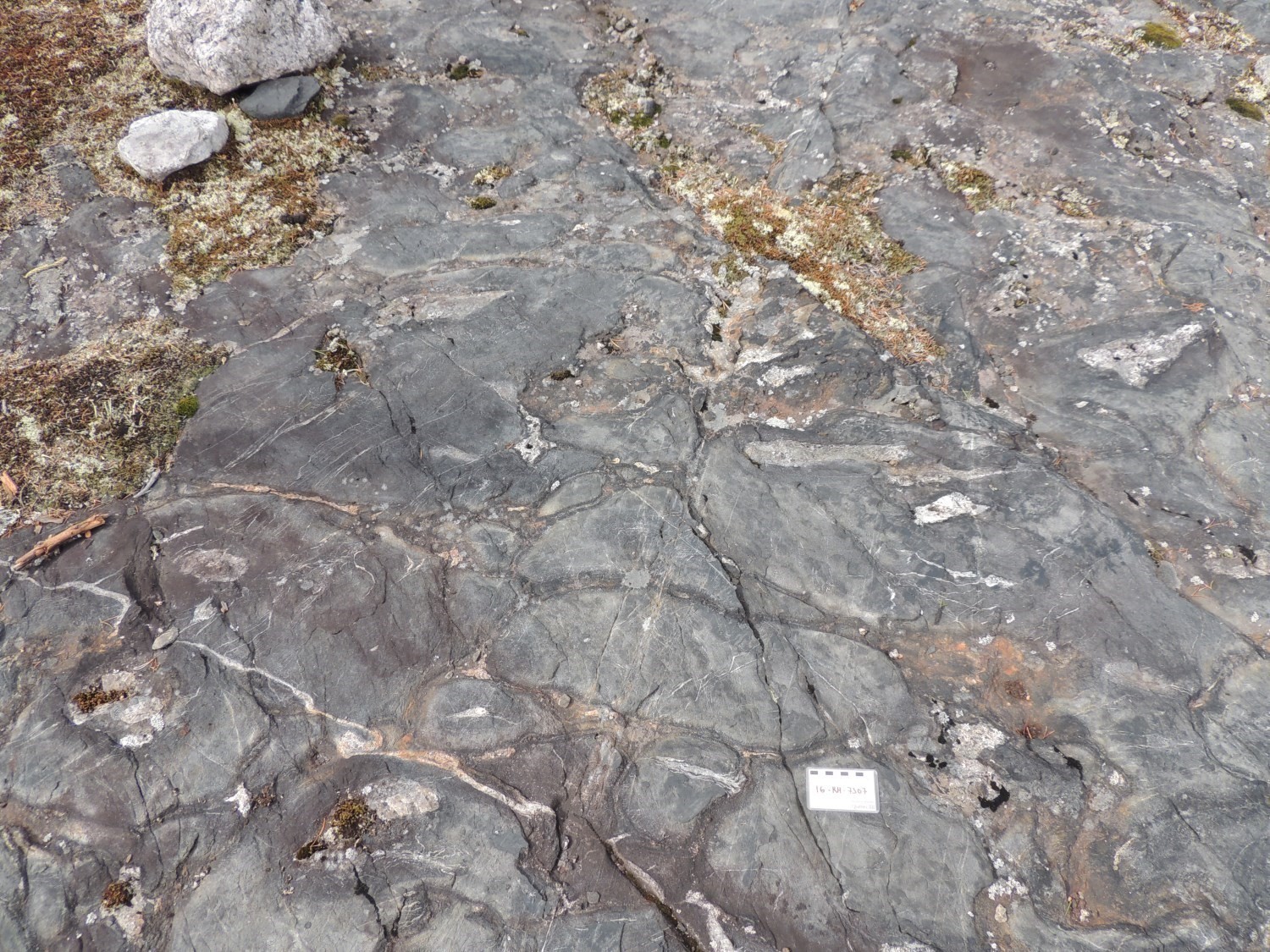
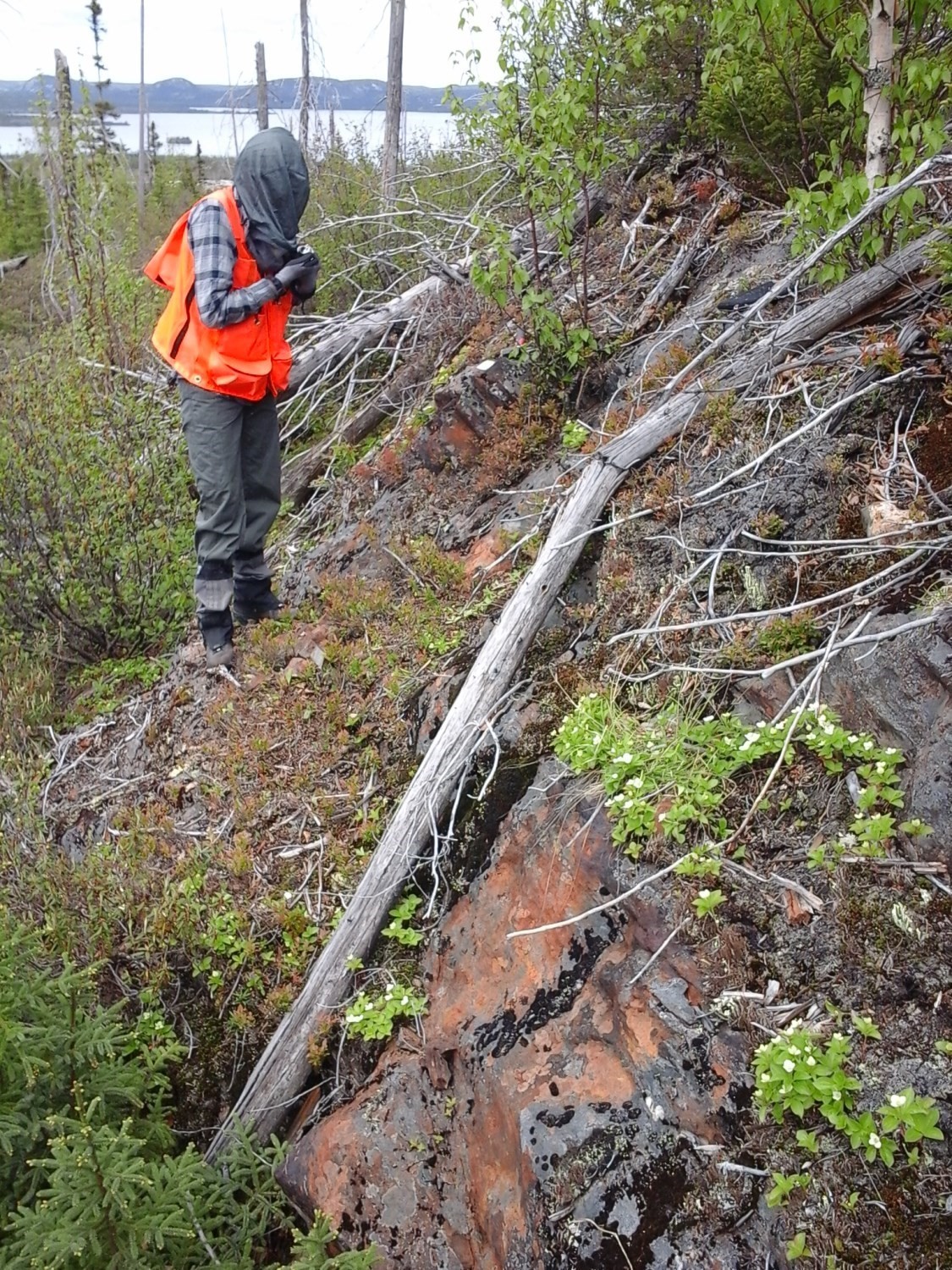
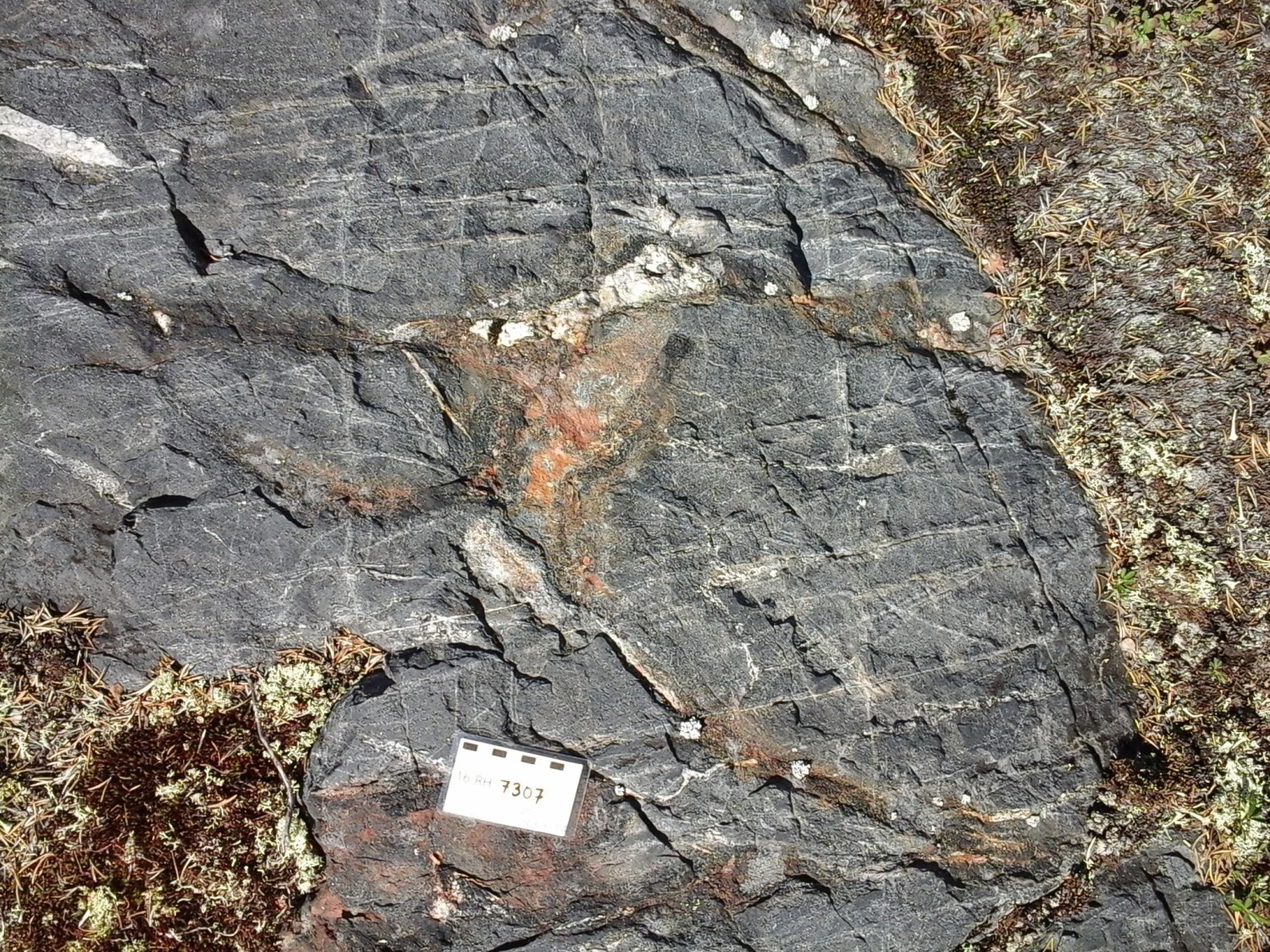
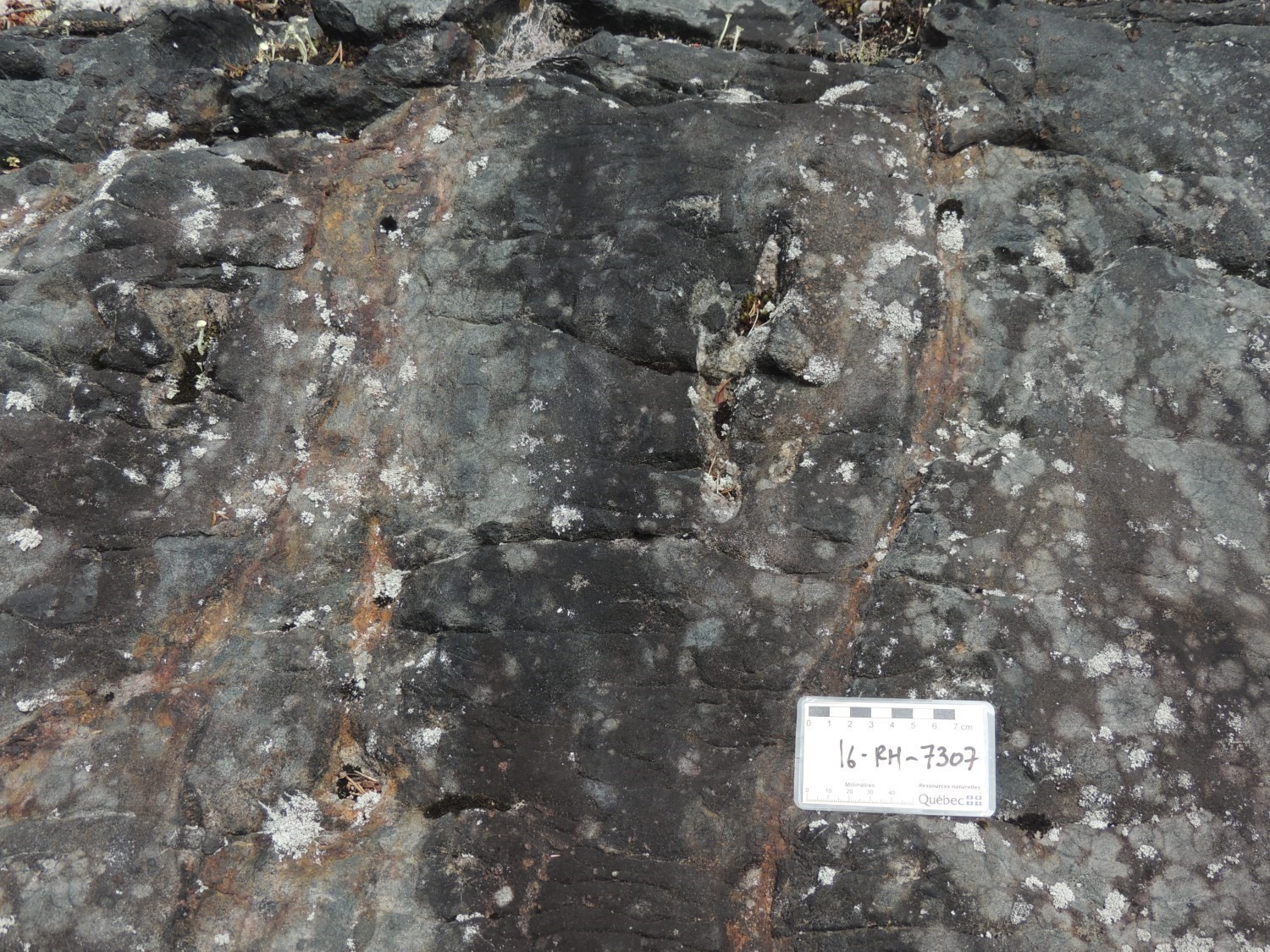 In the Ewart Lake area, a 2.6 km long by 320 m thick metabasalt strip was delineated following geological mapping of sheet 33G04 in 2016. This strip forms a ridge and has a positive magnetic signature (Goldak Airborne Surveys, 2008). It is composed of a massive pillow metabasalt, metamorphosed to the amphibolite facies. The rock has a green to dark grey patina and a dark green fresh surface. Pillows are usually decametric. A few quartz chambers are visible, suggesting a stratigraphic polarity towards the north. Generally, pillows are weakly to moderately deformed, with an apparent flattening on the surface. In the northern part, more deformed and banded layers are observed. The base of this sequence is a metric bed of sulphidic chert, metawacke and pyrrhotite-pyrite metasomatic rock with traces of sphalerite and chalcopyrite (outcrops 2016-RH-7305 and 2016-JG-2709). Diopside, pyrrhotite, pyrite and tourmaline are present in a metawacke sample. These rocks are rusty and stratified. The contact between this unit and the Laguiche Complex paragneisses was not observed.
In the Ewart Lake area, a 2.6 km long by 320 m thick metabasalt strip was delineated following geological mapping of sheet 33G04 in 2016. This strip forms a ridge and has a positive magnetic signature (Goldak Airborne Surveys, 2008). It is composed of a massive pillow metabasalt, metamorphosed to the amphibolite facies. The rock has a green to dark grey patina and a dark green fresh surface. Pillows are usually decametric. A few quartz chambers are visible, suggesting a stratigraphic polarity towards the north. Generally, pillows are weakly to moderately deformed, with an apparent flattening on the surface. In the northern part, more deformed and banded layers are observed. The base of this sequence is a metric bed of sulphidic chert, metawacke and pyrrhotite-pyrite metasomatic rock with traces of sphalerite and chalcopyrite (outcrops 2016-RH-7305 and 2016-JG-2709). Diopside, pyrrhotite, pyrite and tourmaline are present in a metawacke sample. These rocks are rusty and stratified. The contact between this unit and the Laguiche Complex paragneisses was not observed.
These metabasalts commonly show two types of alteration occurring as centimetric bands: 1) plagioclase-quartz-hornblende-diopside ± garnet whitish alteration cutting or following pillow edges; 2) hornblende-garnet-sulphides ± biotite ± quartz ± plagioclase dark green and partially rusted alteration along pillow edges. Disseminated garnet is also observed in pillows. A network of late millimetric quartzofeldspathic veinlets in positive relief affects the metabasalts.
A similar band of metabasalt was observed in the Conviac Lake area during the geological mapping of sheet 33B07 in 2021. It is not associated with a particular magnetic signature or topographic relief. It is nearly 7 km long and about 300 m thick. It is mostly banded amphibolite, whose geochemical composition suggests a hornblende-orthopyroxene-bearing andesitic basalt or basalt protolith. Slightly flattened pillows are observed on one outcrop (2021-MK-3066). These andesitic metabasalts are associated with thin bands of cumulate pyroxenite.
Laguiche Complex 2 (nAlgi2): Paragneiss
Laguiche Complex 2a (nAlgi2a): Biotite ± Garnet Paragneiss Derived from Wacke, Containing <10% Mobilisate and Local Orthopyroxene, Amphibole and Hornblende
 Subunit nAlgi2a covers most of the Laguiche Complex and includes a biotite wacke paragneiss package with or without garnet. It also forms the least migmatized unit (<10% mobilisate, Goutier et al., in preparation). However, with the exception of local compositional and size banding that could correspond to primary bedding (Bandyayera et al., 2011), the primary texture has completely disappeared and has been replaced by a granoblastic texture.
Subunit nAlgi2a covers most of the Laguiche Complex and includes a biotite wacke paragneiss package with or without garnet. It also forms the least migmatized unit (<10% mobilisate, Goutier et al., in preparation). However, with the exception of local compositional and size banding that could correspond to primary bedding (Bandyayera et al., 2011), the primary texture has completely disappeared and has been replaced by a granoblastic texture.
Paragneiss is fine grained and is derived from arkosic wacke. The patina is rusty brown and the fresh surface is light grey. It is generally composed of 10 to 60% quartz, 10 to 30% plagioclase, 1 to 2% K-feldspar, 10 to 35% biotite and 7 to 15% hypersthene with local garnet, hornblende and pyrite or magnetite-type opaque minerals (Hammouche and Burniaux, 2018). Accessory minerals such as tourmaline, rutile, zircon, monazite, apatite, allanite, pyrrhotite, ilmenite and diopside are also observed in thin section (Gigon et al., 2020). The alteration layer can be seen by sericitization of plagioclase, uralitization of hypersthene and weak serpentinization of hypersthene cracks.
The mobilisate is whitish, granitic and appears either in thin bands (stromatic texture) parallel to foliation, or diffuse (diffuse contact with restite). It is commonly affected by tight or ptygmatic folds. In the case of medium-grained paragneiss, biotite and garnet are particularly visible.
Laguiche Complex 2b (nAlgi2b): Nodular Biotite ± Hornblende ± Garnet ± Cordierite ± Sillimanite Paragneiss, Containing <20% Mobilisate
Subunit nAlgi2b unit consists of nodular paragneiss containing <20% mobilisate. Simard and Gosselin (1999) defined it as unit Alu2 of the Laguiche Group. This unit predominantly occurs in SW James Bay (Bandyayera et al., 2010). Occurrences have been observed in the northern part, but are too small to be mapped. Nodular paragneiss forms weakly migmatized kilometric strips. Subunit nAlgi2b differs from subunit nAlgi2a because of its garnet content: nodular paragneiss is rich in aluminosilicates and garnet. Nodules consist of cordierite, andalsite or sillimanite porphyroblasts. These nodules are in positive relief on outcrops and can be up to 5 cm in diameter. They also highlight banding between layers that are rich and poor in aluminosilicates, respectively; these layers can be interpreted as a primary bedding relic.
Laguiche Complex 2c (nAlgi2c): Biotite ± Cordierite ± Sillimanite Paragneiss and Metatexite Derived from Wacke and Arenite
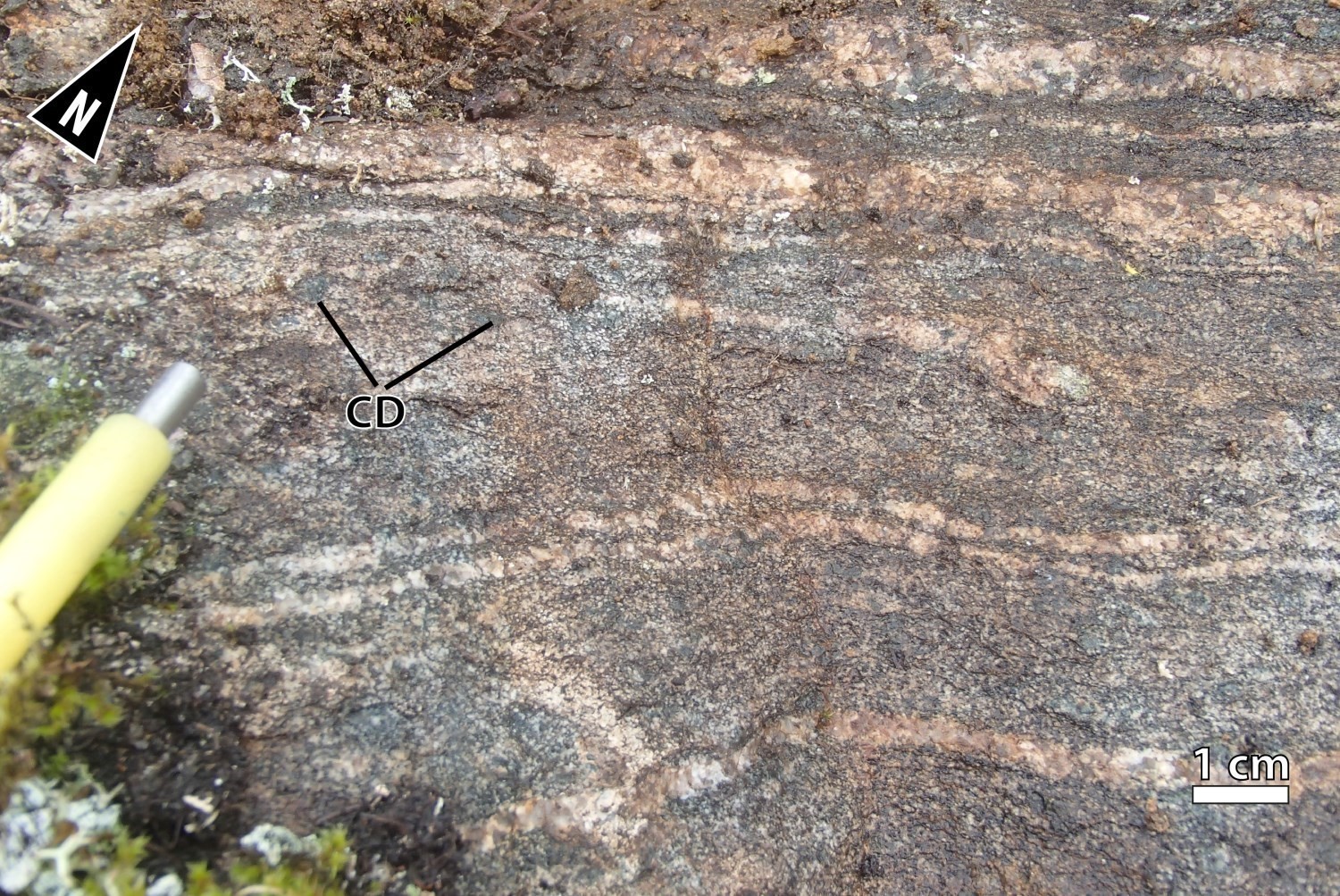
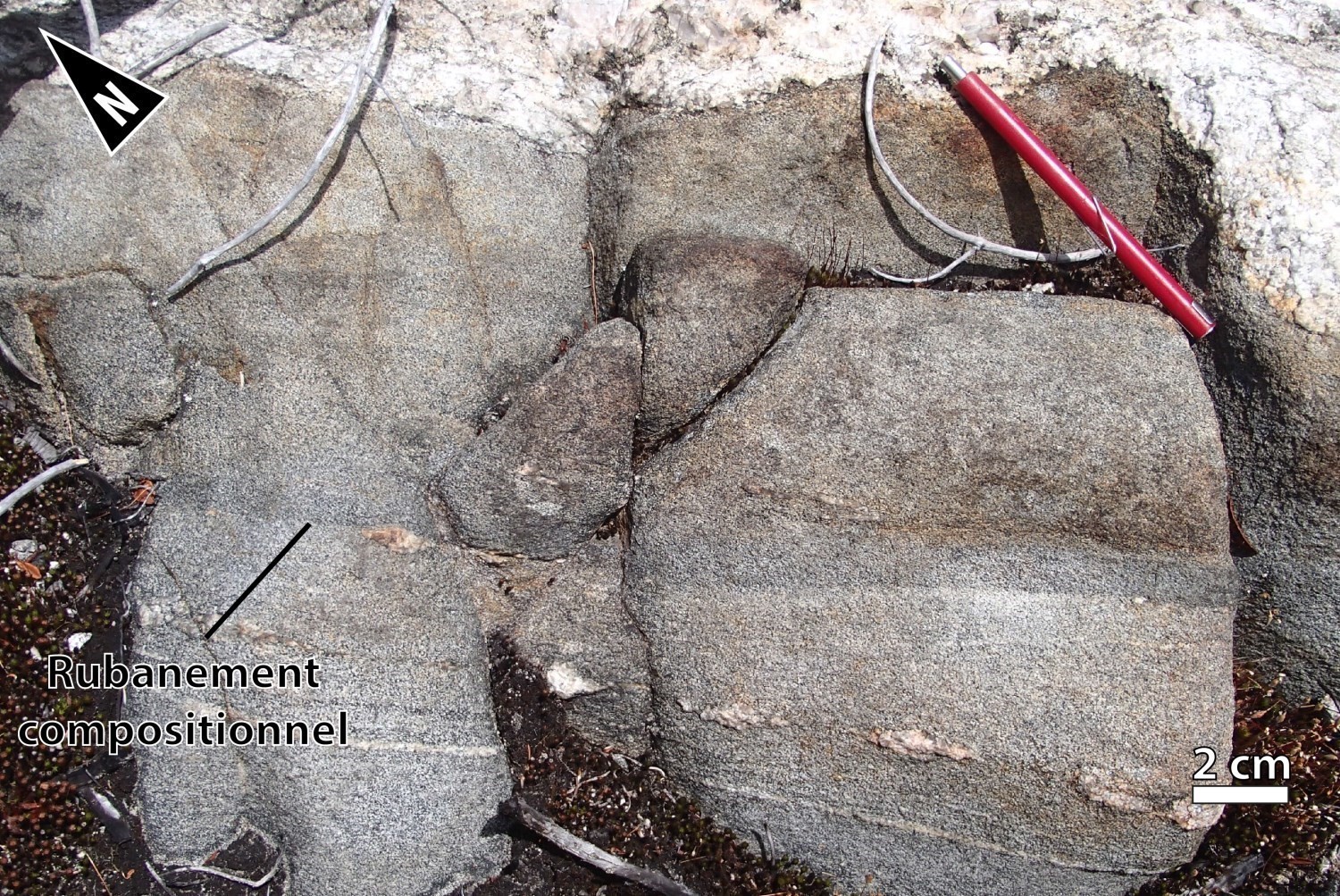 This subunit was identified (Beauchamp, 2020) in the areas of Cadieux Lake and Bohier Island, south of the Eastmain-Sorbier Shear Zone (sheets 33A07, 33A02 and 33A01). It consists of wacke paragneisses and metatexites containing biotite and locally garnet or cordierite porphyroblasts. Typically, the mobilisate content is <10%. Locally, it can reach up to 50%, and these rocks are then described as wacke metatexites. In thin section, the rock is mostly composed of quartz, plagioclase, K-feldspar and biotite. Plagioclase is weakly to moderately damouritized. This subunit is characterized by less biotite (15%) than in subunit nAlgi2a (20-25%). The primary texture is commonly completely obliterated by the granoblastic texture. Compositional and size banding could represent a primary bedding relic. Masses of cordierite poikiloblasts replaced by pinnite, and in lesser proportions by chlorite, are present in some more pelitic migmatized beds. Chlorite-plagioclase metamorphic coronas have developed around some cordierite poikiloblasts. Several thin sections display symplectic intergrowth of biotite-quartz, biotite-plagioclase and biotite-cordierite corresponding to relics of anatectic liquid. The rocks contain traces of hornblende, apatite, zircon, muscovite, epidote (pistachite, allanite), magnetite, ilmenite, iron oxides and other opaque minerals.
This subunit was identified (Beauchamp, 2020) in the areas of Cadieux Lake and Bohier Island, south of the Eastmain-Sorbier Shear Zone (sheets 33A07, 33A02 and 33A01). It consists of wacke paragneisses and metatexites containing biotite and locally garnet or cordierite porphyroblasts. Typically, the mobilisate content is <10%. Locally, it can reach up to 50%, and these rocks are then described as wacke metatexites. In thin section, the rock is mostly composed of quartz, plagioclase, K-feldspar and biotite. Plagioclase is weakly to moderately damouritized. This subunit is characterized by less biotite (15%) than in subunit nAlgi2a (20-25%). The primary texture is commonly completely obliterated by the granoblastic texture. Compositional and size banding could represent a primary bedding relic. Masses of cordierite poikiloblasts replaced by pinnite, and in lesser proportions by chlorite, are present in some more pelitic migmatized beds. Chlorite-plagioclase metamorphic coronas have developed around some cordierite poikiloblasts. Several thin sections display symplectic intergrowth of biotite-quartz, biotite-plagioclase and biotite-cordierite corresponding to relics of anatectic liquid. The rocks contain traces of hornblende, apatite, zircon, muscovite, epidote (pistachite, allanite), magnetite, ilmenite, iron oxides and other opaque minerals.
Several generations of mobilisate are present on outcrops. Thin felsic whitish bands, millimetre-to-centimetre-thick, are interpreted as in situ mobilisate. Decimetric stromatic veins and injections appear to correspond to a mobilisate that migrated from its original source. On some outcrops, however, it is difficult to distinguish between magmatic and mobilisate injections. Foliated to massive whitish granite with solid, homogeneous to heterogeneous and hololeucocratic is widespread in the metasedimentary basin. On several outcrops, granite containing paragneiss or metatexite enclaves is predominant. Small intrusive masses belonging to the Martel Suite cut rocks of the nAlgi2c subunit.
Laguiche Complex 3 (nAlgi3): Paragneiss and Metatexite
Laguiche Complex 3a (nAlgi3a): Biotite ± Garnet Metatexite Derived from Paragneiss, Containing 10-50% Mobilisate with Local Orthopyroxene and Amphibole, Migmatitzed Paragneiss
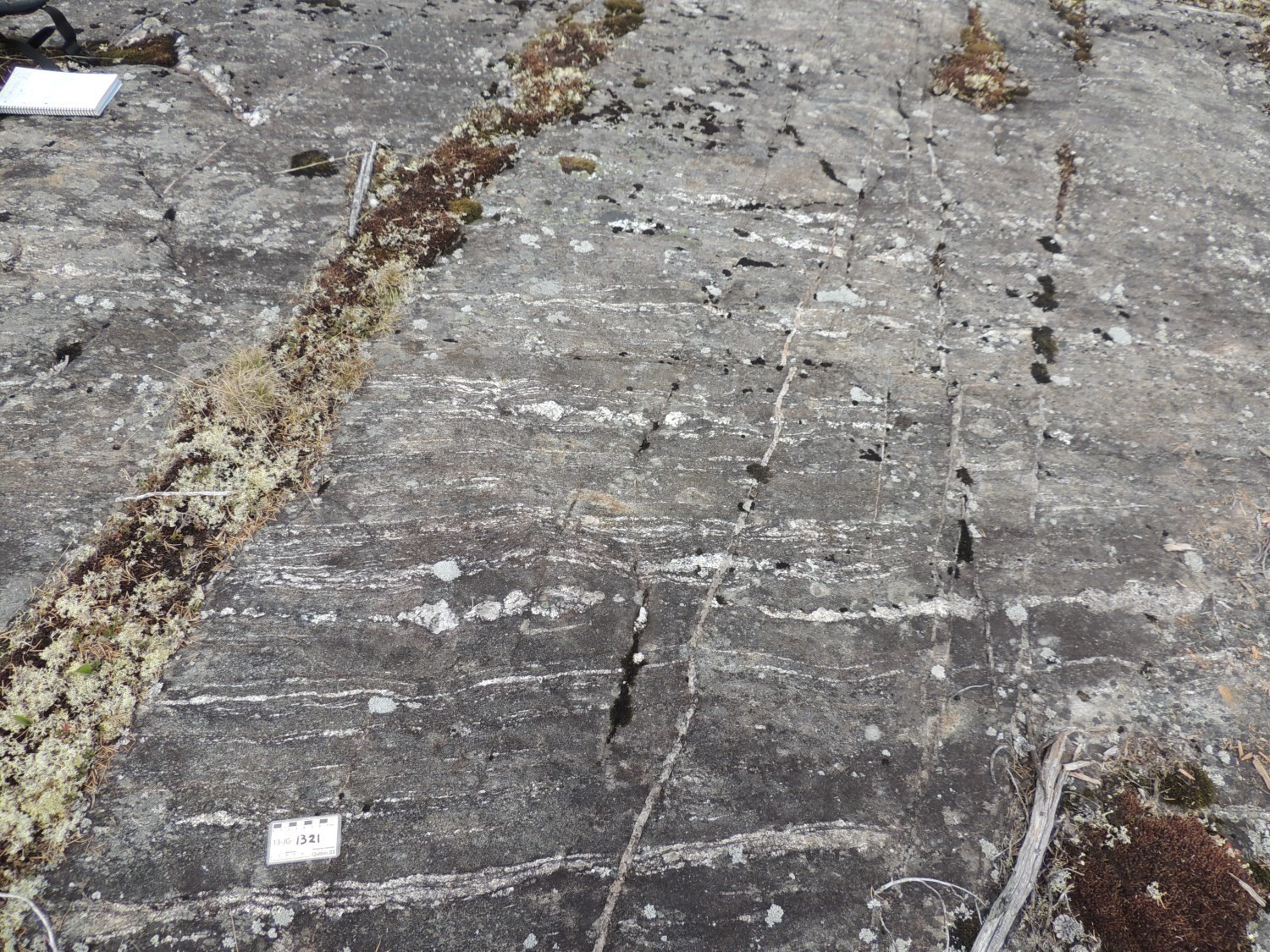 Subunit nAlgi3a differs from subunit nAlgi2a unit only by the proportion of mobilisate (10-50%) that transforms the paragneiss into metatexite (Hammouche and Burniaux, 2018). Restite is fine grained and arkosic in composition, containing 20 to 25% quartz, 10% feldspar, 10 to 15% biotite, 15% hypersthene, 2 to 3% garnet, 2 to 5% cordierite and 15% amphibole in places. Biotite usually forms schlierens in contact with the mobilisate. The main accessory minerals are zircon, magnetite and pyrite. Garnet, hypersthene and amphiboles indicate a metamorphic assemblage. Types of alteration include damouritization of plagioclase, chloritization of biotite and replacement of orthopyroxene by hydrous phases such as biotite, cummingtonite or anthophyllite.
Subunit nAlgi3a differs from subunit nAlgi2a unit only by the proportion of mobilisate (10-50%) that transforms the paragneiss into metatexite (Hammouche and Burniaux, 2018). Restite is fine grained and arkosic in composition, containing 20 to 25% quartz, 10% feldspar, 10 to 15% biotite, 15% hypersthene, 2 to 3% garnet, 2 to 5% cordierite and 15% amphibole in places. Biotite usually forms schlierens in contact with the mobilisate. The main accessory minerals are zircon, magnetite and pyrite. Garnet, hypersthene and amphiboles indicate a metamorphic assemblage. Types of alteration include damouritization of plagioclase, chloritization of biotite and replacement of orthopyroxene by hydrous phases such as biotite, cummingtonite or anthophyllite.
The mobilisate varies from grey-white to pink-grey. Its composition is granitic and its structure is stromatic. In addition, it is possible to observe ptygmatic, folded or phlebitic structures. Millimetric banding can also be observed, although it may be late intrusions unrelated to partial melting of the rock.
The presence of leucosome clusters rich in coarse garnet, quartz inclusions in garnet, and melanosome rims around leucosome are evidence of in situ partial melting (Sawyer, 2008). Cordierite closely associated with garnet is also observed in outcrop and thin section.
Despite intense migmatization, the paragneiss shows compositional bands marked by alternating biotite-rich beds and hornblende-rich beds that may reflect primary bedding (Bandyayera et al., 2010).
Laguiche Complex 3b (nAlgi3b): Migmatized Nodular Paragneiss
Subunit nAlgi3b consists of a migmatized nodular paragneiss package containing 20 to 50% mobilisate (Bandyayera et al., 2010). As with subunit nAlgi2b, some occurrences are observed in the northern part of the complex, but they are only consistent with non-mappable units. Subunit nAlgi3b is very similar to subunit nAlgi2b, the difference is in the proportion of mobilisate. This subunit is very geographically restricted and rocks of this family appear only in sheets 33B12 and 33B13. Some bands show enrichment in aluminosilicates, alternating with other bands rich in biotite ± hornblende ± garnets. Garnet-tourmaline pegmatitic dykes cut the paragneiss package.
Laguiche Complex 4 (nAlgi4): Diatexite: Migmatite Derived from Paragneiss
Unit nAlgi4 consists of diatexite derived from paragneiss. More specifically, it is found in the SW part of the Laguiche Complex, in an area defined by Bandyayera et al. (2010). These diatexites are composed of 50% mobilisate. Units nAlgi4 and nAlgi4a consist of similar rocks, but correspond to two different geographic areas. Bandyayera et al. (2010) define the nAlgi4 unit in SW James Bay, while Gigon and Goutier (2017) and Hammouche and Burniaux (2018) use the nAlgi4a unit for diatexites containing >50% mobilisate in northern James Bay.
Laguiche Complex 4a (nAlgi4a): Biotite ± Garnet Diatexite Derived from Paragneiss, Containing 50% Mobilisate and Local Orthopyroxene and Amphibole
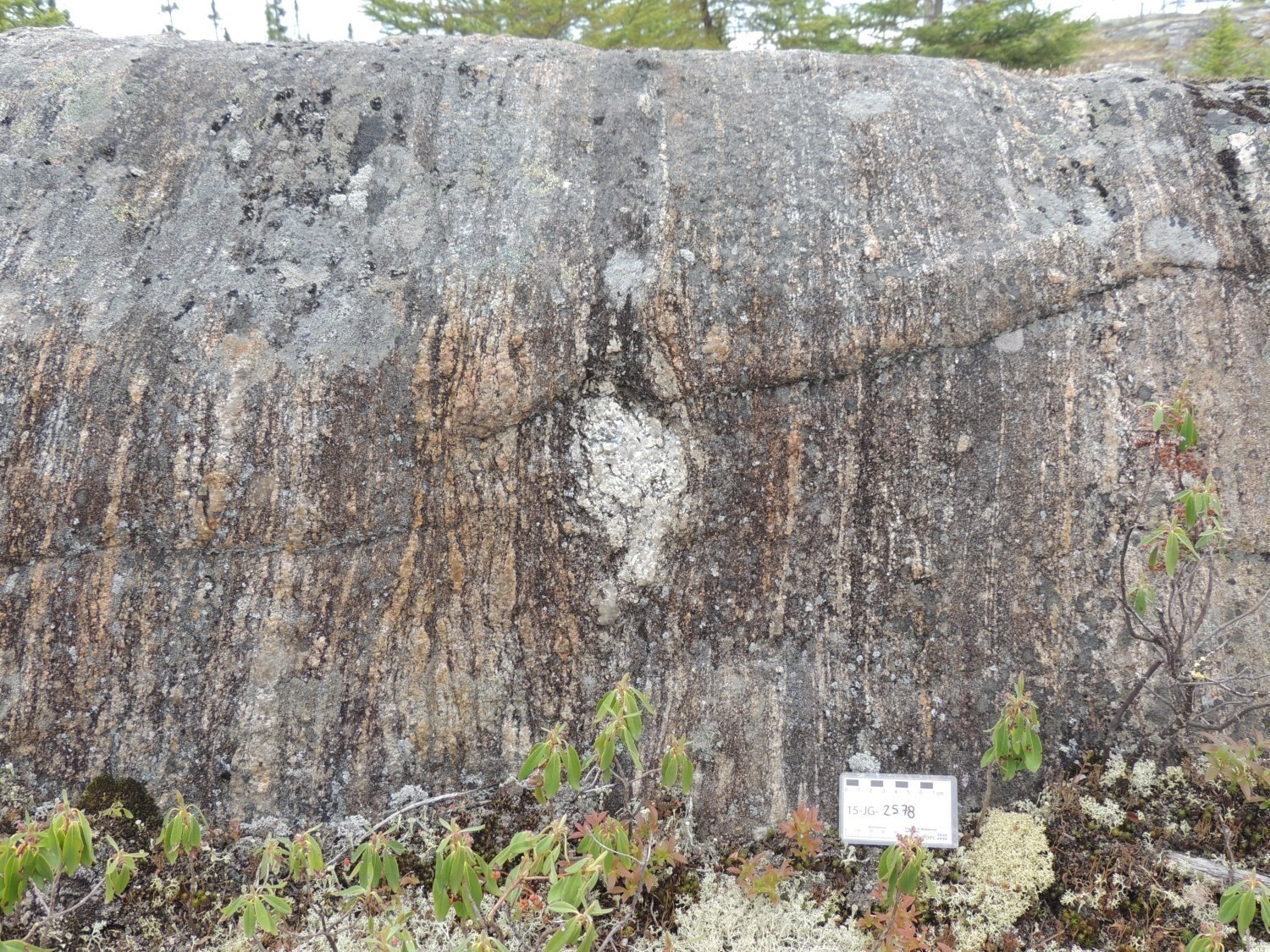 Subunit nAlgi4a consists of heterogeneous and banded diatexite composed of biotite, hornblende, garnet and pyroxene (Bandyayera et al., 2010). They are the most migmatized rocks and are composed of >50% mobilisate and intrusions. The composition of this mobilisate varies from tonalitic to granodioritic. Rock banding is chaotic on outcrop with mobilisate-rich areas and others enriched in stretched enclaves of biotite ± hornblende paragneiss, locally pyroxene ± garnet. Biotite, hornblende, magnetite and garnet crystals are found in high concentrations near leucosomes, while orthopyroxene and clinopyroxene are observed in both the mobilisate and paragneiss enclaves or restites.
Subunit nAlgi4a consists of heterogeneous and banded diatexite composed of biotite, hornblende, garnet and pyroxene (Bandyayera et al., 2010). They are the most migmatized rocks and are composed of >50% mobilisate and intrusions. The composition of this mobilisate varies from tonalitic to granodioritic. Rock banding is chaotic on outcrop with mobilisate-rich areas and others enriched in stretched enclaves of biotite ± hornblende paragneiss, locally pyroxene ± garnet. Biotite, hornblende, magnetite and garnet crystals are found in high concentrations near leucosomes, while orthopyroxene and clinopyroxene are observed in both the mobilisate and paragneiss enclaves or restites.
Within diatexites, preserved enclaves of amphibolite and tonalite are visible. There are also polyphase injections of conformable or unconformable mobilisate. Late pegmatitic intrusions (containing crystals exhibiting a graphic texture up to 70 cm in diameter) cut the whole sequence and, in particular, migmatitic banding.
Laguiche Complex 4b (nAlgi4b): Diatexite Derived from Paragneiss and Intermediate Rocks, Anatectic Granite
This subunit was introduced following mapping of the Cadieux Lake area (Beauchamp, 2020). It consists mainly of diatexite, anatectic granite and, to a lesser extent, metatexite. These migmatized rocks are believed to be the result of melting of metasedimentary rocks (wacke paragneiss) and intermediate intrusive rocks (quartz diorite and diorite). It is a very heterogeneous and heterogranular unit that includes rafts, schollens and more or less assimilated granoblastic enclaves of paragneiss and dioritic rocks. Irregular migmatitic banding caused by creep was formed when deformation was at a subsolidus stage under stress. Ptygmatic and chaotic folding and porphyritic textures isolating centimetric feldspar crystals in a mass of biotite characterize rocks of the nAlgi4b subunit. Stromatic textures and biotite schlierens are common. The mobilisate has a granitic to granodioritic geochemistry and is mainly composed of quartz, plagioclase and microcline. In thin section, quartz is sutured and shows undulatory extinction. Myrmekites are common. Traces of chlorite, epidote, muscovite, apatite, zircon, monazite, allanite, magnetite, iron oxides and other opaque minerals were also observed. Magmatic intrusions of homogeneous pinkish-white biotite ± magnetite ± amphibole granite also occur within the subunit.
Laguiche Complex 5 (nAlgi5): Migmatized Amphibolite, Locally of Gabbroic Origin, Migmatized Diorite
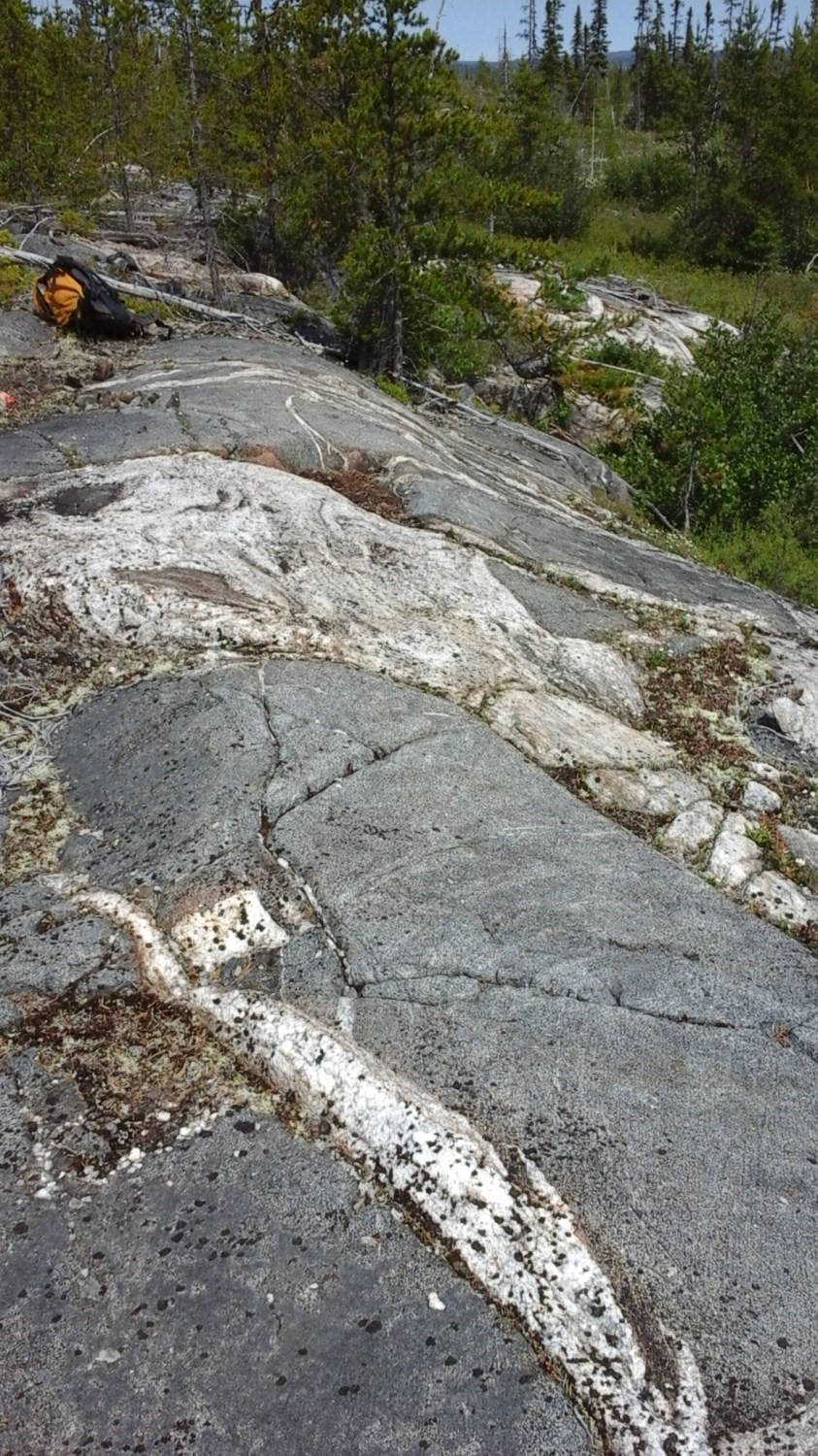 Unit nAlgi5 consists of hornblende ± diopside ± biotite amphibolite. Simard and Gosselin (1999) were the first to describe the amphibolite and amphibole gneiss units (unit Alu5) interbedded in the paragneiss sequences. These units are generally small and are heavily intruded by granitic mobilisate.
Unit nAlgi5 consists of hornblende ± diopside ± biotite amphibolite. Simard and Gosselin (1999) were the first to describe the amphibolite and amphibole gneiss units (unit Alu5) interbedded in the paragneiss sequences. These units are generally small and are heavily intruded by granitic mobilisate.
The protolith is likely to be a metamorphosed, intermediate to mafic intrusive rock within metasedimentary rocks. Its primary mineralogy consists of hornblende (40-50%), diopside (1-5%), sulphides, sphene and biotite locally (Gigon et al., 2020). In outcrop, the rock has a greyish patina and a medium to dark green fresh surface. It is slightly foliated, fine grained and granoblastic. Compositional banding is visible between layers either richer in ferromagnesian minerals or in plagioclase.
Laguiche Complex 6 (nAlgi6): Felsic Tuff, Polymictic Conglomerate and Iron Formation
 Unit nAlgi6 consists of a series of felsic tuffs, polymictic conglomerates and iron formations defined by Goutier et al. (2000). It outcrops along the Transtaïga Road, around km 85 (sheet 33F09). This unit had previously been assigned to the Yasinski Group (Fallara et al., 1999), but stratigraphic continuity between these rocks and sedimentary rocks of the Laguiche Complex have been discovered. This is the upper unit of the Laguiche Complex, located in the centre of a southward overturned syncline. The maximum preserved thickness is 200 m.
Unit nAlgi6 consists of a series of felsic tuffs, polymictic conglomerates and iron formations defined by Goutier et al. (2000). It outcrops along the Transtaïga Road, around km 85 (sheet 33F09). This unit had previously been assigned to the Yasinski Group (Fallara et al., 1999), but stratigraphic continuity between these rocks and sedimentary rocks of the Laguiche Complex have been discovered. This is the upper unit of the Laguiche Complex, located in the centre of a southward overturned syncline. The maximum preserved thickness is 200 m.
The dominant rock type of the Algi6 unit is a felsic tuff with a white patina and brownish-grey fresh surface. It contains millimetric crystals of plagioclase floating in a finer quartzofeldspathic matrix. These crystals are clearly visible on the altered patina. In cases where the surface of the outcrop is clean and sedimentary structures are attenuated, the rock resembles a fine-grained porphyritic intrusion. Quartz phenocrystals are scarce (≤7% of the rock). The felsic tuff appears as thin to medium, sorted beds with parallel laminations at the top of the beds. When beds are thick and massive, contacts are diffuse. Centimetric to metric intervals of thin sorted mudstone beds are interstratified with the felsic tuff. Layers of lapilli pyroclastic rocks are sparser. A few decametric to metric lamprophyre dykes containing tuff and iron formation enclaves cut this sequence. These dykes have sometimes been confused with block tuffs (11144-C1, TRH-96-13; Fallara et al., 1999). They are grey to green, fine grained, in an amphibole matrix and contain some biotite. The shape of the fragments in these dykes varies from angular to rounded.
One of the features of the nAlgi6 unit is the presence of a gold-bearing oxide-silicate facies iron formation and a polymictic conglomerate containing chert fragments. These two lithologies are generally adjacent. They are located next to the wacke-felsic tuff contact in each flank of the syncline. The thickness of the iron formation-conglomerate package does not exceed 5 m. Conglomerate beds are lenticular, whereas the iron formation is rather continuous and shows decametric lateral extension. The latter consists of millimetric beds of magnetite and chert with a variable proportion of silicate-rich millimetric to centimetric beds (grunerite-hornblende ± garnet ± biotite). The polymictic conglomerate consists mainly of lenticular and subangular pebbles and stones of white feldspathic porphyry, chert and amphibolite. More locally, fragments of iron formation, amphibole andesite and mudstone are observed. Beds are massive to sorted and fragments are usually joint. The matrix is dark due to the presence of amphiboles.
Laguiche Complex 7 (nAlgi7): Metamorphosed and foliated Biotite Wacke, Alternating Feldspathic Wacke and Mudrock
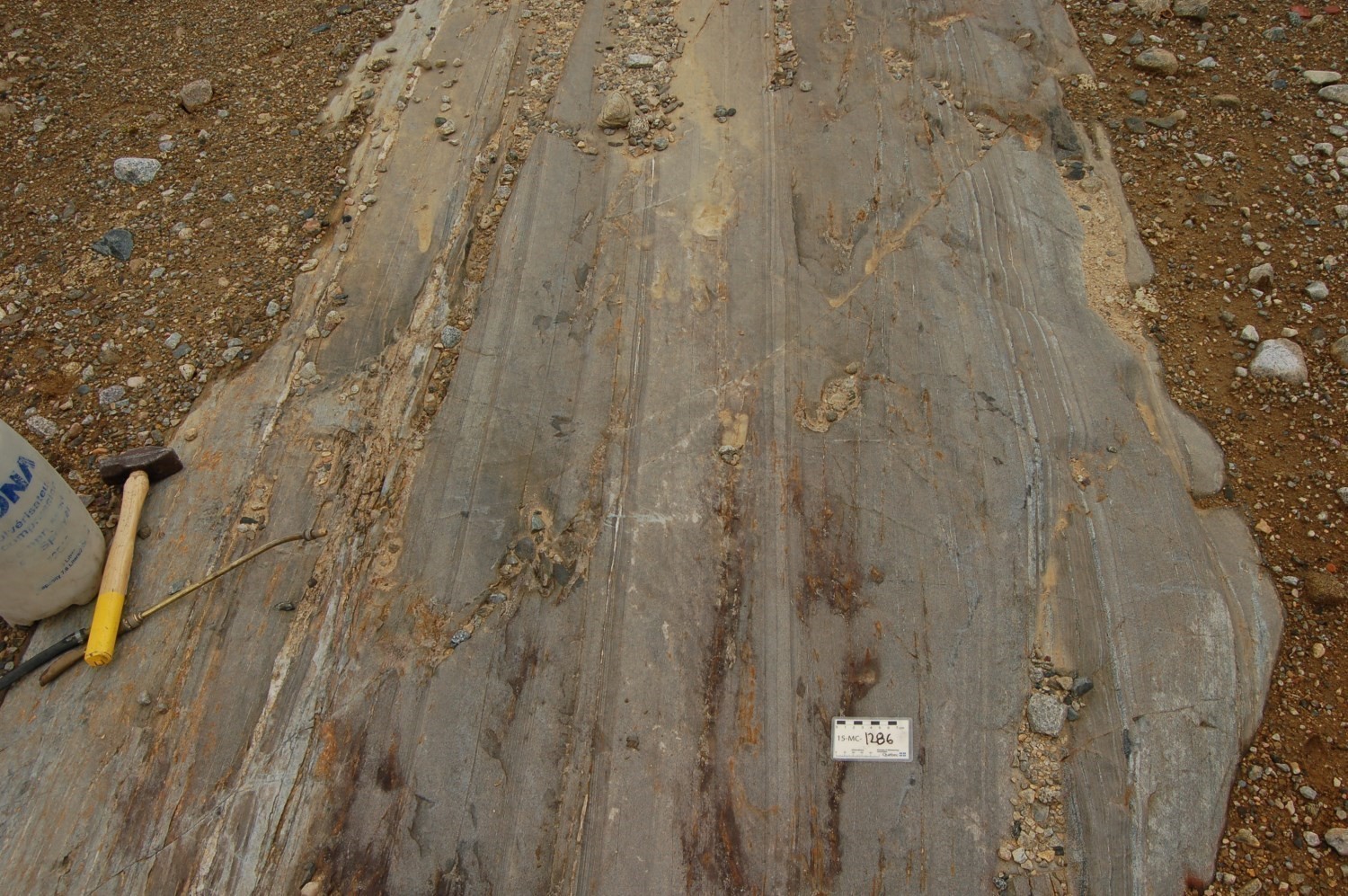 Unit nAlgi7 consists mainly of metamorphosed biotite wacke. Previously, this unit was part of unit Alu1 of the Laguiche Group defined by Simard and Gosselin (1999). This unit is present in the east-centre part of sheet 33F. Primary sedimentary structures within metamorphosed the wackedistinguish it from paragneiss units. In addition, the presence of chlorite gives a green colour to the rock on a fresh surface, while paragneiss have a greyish fresh surface. The wacke is fine grained, foliated and homogeneous. It is more common to find carbonates and epidote in this type of rock (Gigon et al., 2020).
Unit nAlgi7 consists mainly of metamorphosed biotite wacke. Previously, this unit was part of unit Alu1 of the Laguiche Group defined by Simard and Gosselin (1999). This unit is present in the east-centre part of sheet 33F. Primary sedimentary structures within metamorphosed the wackedistinguish it from paragneiss units. In addition, the presence of chlorite gives a green colour to the rock on a fresh surface, while paragneiss have a greyish fresh surface. The wacke is fine grained, foliated and homogeneous. It is more common to find carbonates and epidote in this type of rock (Gigon et al., 2020).
Turbidite structures occurring as thin to medium sorted beds are observed in many places in metamorphosed wacke. The base of some beds is composed of polymictic granules as observed in the Sakami Lake area (sheet 33F07, Goutier et al., 2000). Mudrock is interstratified with wacke and more abundant in the area. It has a brown or green patina and commonly exhibits parallel laminations. Fine biotite is widely developed, while garnet and amphibole are more rarely observed. Some beds of polymictic conglomerate containing quartz, arenite, biotite schist, amphibolite or felsic rock granules are interstratified within the wacke.
Laguiche Complex 8 (nAlgi8): Package of Paragneiss Derived from Wacke, Magnetite Paragneiss, Altered and Sheared Paragneiss Bands, and Graphite-Sulphide Schist
Unit nAlgi8 is a set of paragneisses derived from wacke, magnetite paragneiss, altered and sheared paragneiss bands, and graphite-sulphide schist. A geographic type area defines this unit, located in the SE corner of sheet 33F08 and measuring 3 km long by 200 m wide (Gigon et al., 2020).
The paragneisses are usually foliated and some bands are sheared. The mobilisate is poorly represented in this unit. It is characterized by high concentrations of pyrrhotite, graphite and amphibole. The schist layers derived from graphite-sulphide mudstone show a darker and finer matrix than other paragneiss lithologies. They vary in thickness from 25 to 75 cm. There are centimetric to metric injections of granite containing biotite, tourmaline and muscovite.
Centimetric to decametric, conformable and unconformable alteration layers are also present in this unit. They contain diopside, quartz, plagioclase, microcline, amphibole and sulphides.
Laguiche Complex 9 (nAlgi9): Iron Formation
Unit nAlgi9, located in sheet 33F09, consists of iron formations which were previously part of the Alu4 unit of the “Laguiche Group” established by Simard and Gosselin (1999). These iron formations are a few metres thick and their lateral extent is limited. Iron formations are banded and exhibit alternating centimetric to decametric magnetite bands and recrystallized whitish chert laminae.
Laguiche Complex 10 (nAlgi10): Polymictic Conglomerate
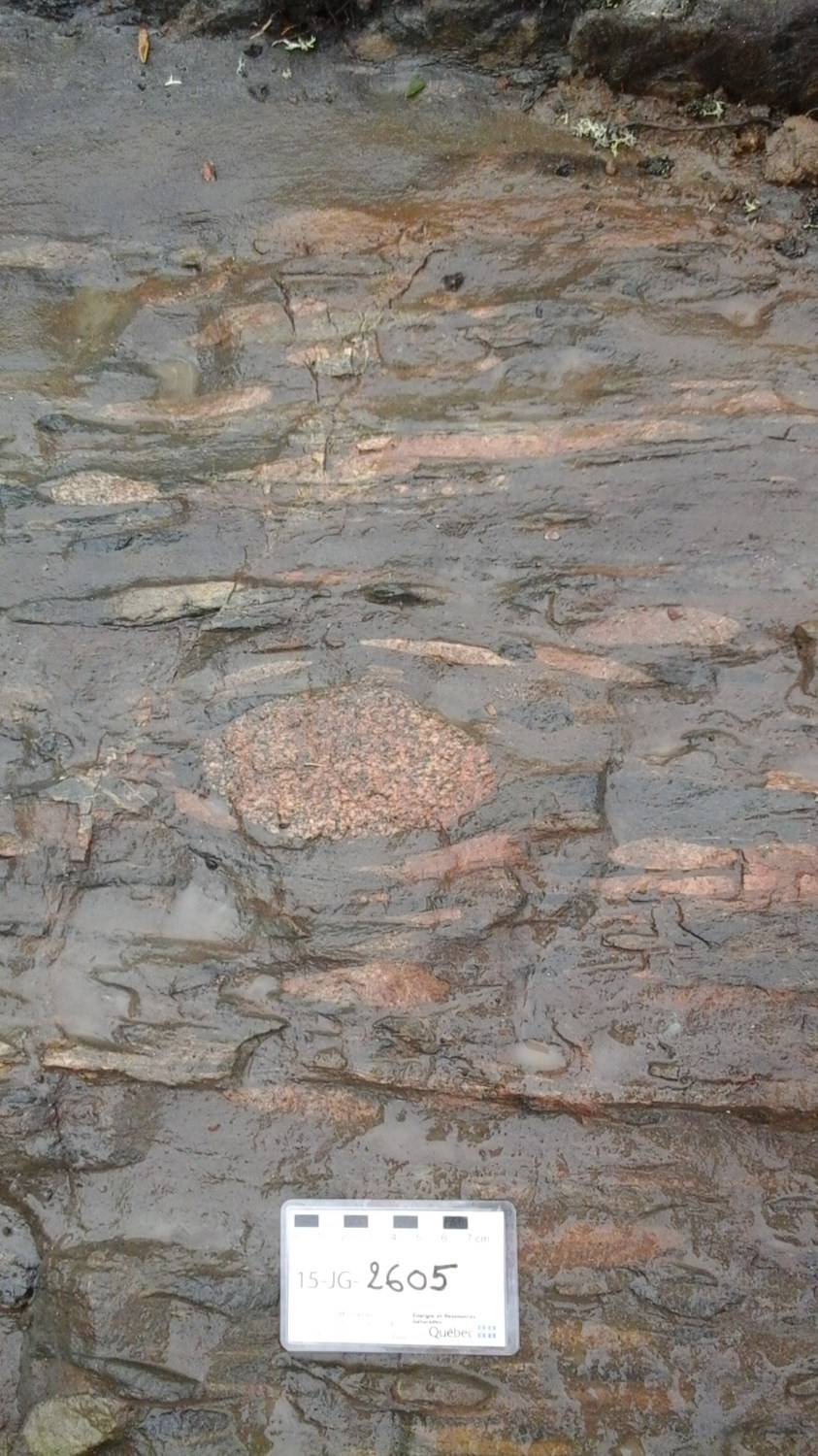
 Unit nAlgi10 consists of a few beds of polymictic joint granule and pebble conglomerate interstratified within wacke. The most important lens is located SE of Bonfait Lake (sheet 33F09). It consists of metric beds of polymictic conglomerate containing rounded pebbles of various lithologies, including basalt, gabbro, tonalite, quartz, arenite, biotite, amphibolite and felsic rock (Goutier et al., 2001). A second lens is located in the NE portion of sheet 33G05 along the Transtaïga Road. This unit marks the contact between the La Grande and Opinaca subprovinces. It has been deformed, as shown by L/S tectonite, foliation and shear evidence. The majority of the matrix consists of biotite (10-20%), amphibole (5-20%), and traces of pyrite and chlorite.
Unit nAlgi10 consists of a few beds of polymictic joint granule and pebble conglomerate interstratified within wacke. The most important lens is located SE of Bonfait Lake (sheet 33F09). It consists of metric beds of polymictic conglomerate containing rounded pebbles of various lithologies, including basalt, gabbro, tonalite, quartz, arenite, biotite, amphibolite and felsic rock (Goutier et al., 2001). A second lens is located in the NE portion of sheet 33G05 along the Transtaïga Road. This unit marks the contact between the La Grande and Opinaca subprovinces. It has been deformed, as shown by L/S tectonite, foliation and shear evidence. The majority of the matrix consists of biotite (10-20%), amphibole (5-20%), and traces of pyrite and chlorite.
In the Cadieux Lake area (sheet 33A02, outcrops 2018-AB-1053, 2018-AB-1056 and 2018-AB-1057), thin beds of polymictic conglomerate containing floating fragments in a paragneiss matrix outcrop within subunit nAlgi2a (Beauchamp, 2020). The conglomerate is granoblastic and has a matrix of quartz, feldspar and biotite with a lesser amount of chlorite, muscovite and pinnitized cordierite poikiloblasts. The most common clasts are rounded and consist of medium-grained felsic intrusive rocks (granodiorite or tonalite), locally foliated (5%). There are a few clasts of biotite-quartz diorite and paragneiss. The conglomerate is weakly to highly migmatized. It contains 2 to 40% thin folded, discontinuous and boudinaged leucosomes.
Other non-mappable occurrences were identified during the works conducted in 2015 and 2016. Occurrences of conglomerate belonging to the Laguiche Complex have been identified in the north part of the Opinaca Subprovince. They are generally concentrated within 10 km of the border of this subprovince.
Laguiche Complex 11 (nAlgi11): Hornblende or Amphibole-Biotite Gneiss
The Gorge Prosper Gneisses are located in sheets 33B01 and 33B02 and correspond to unit Alu3 of Simard and Gosselin (1999), which was later replaced by unit nAlgi11 during the current compilation. They were named and described by Franconi (1983). According to Franconi (1983), the typical sequence is banded, in places with stratiform flow, and consists of alternating mesocratic gneiss, finely banded gneiss (repetition of leucocratic and melanoratic centimetric bands) and amphibole-rich melanoratic gneiss.
The mesocratic gneiss is the most common facies. Macroscopically, rocks are homogeneous, fine to medium grained, and have a brownish to greenish-grey patina and a greyish fresh surface. They contain 20 to 35% ferromagnesian minerals (amphibole and biotite) in small stocky crystals distributed homogeneously, giving them a salt and pepper appearance. They do not display pronounced foliation; some facies that are rich in dark minerals show at most a vague schistosity. The finely banded gneiss, which is fairly common, consists of repetitive alternating leucocratic, medium-grained bands, composed of a combination of plagioclase and quartz crystals, and thinner biotitic bands (2-4 cm). Leucocratic bands contain 8 to 10% biotite and have an indured appearance. In addition, the patina and fresh surface have a very light greenish colour. Finally, the less common melanocratic amphibole gneiss is strongly banded and contains lighter bands of the same composition as those characterizing the finely banded gneiss. In places, it is homogeneous and not banded.
Laguiche Complex 12 (nAlgi12): Migmatized Paragneiss and Biotite Paragneiss Locally
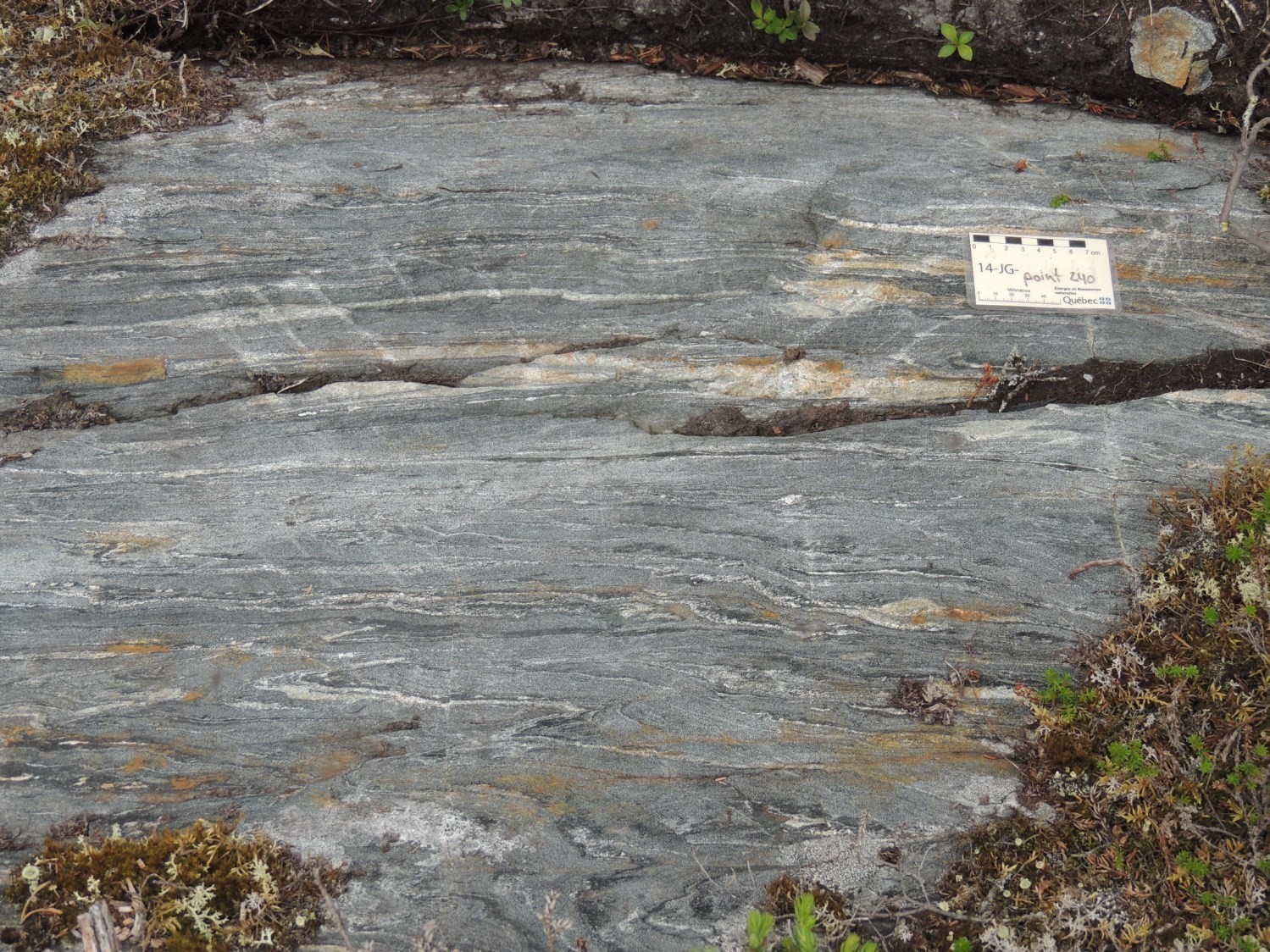 Unit nAlgi12 consists of migmatized paragneiss and biotite paragneiss. Originally, Simard and Gosselin (1999) defined the Alu1 biotite paragneiss unit. This unit was also defined by Goutier et al. (2001). This paragneiss is fine grained and is composed of quartz, plagioclase and biotite. Accessory minerals observed are garnet, hornblende, cummingtonite, tourmaline, cordierite, chlorite and magnetite. The texture is generally granoblastic and the foliation is visible by the orientation of biotite grains. The degree of migmatization is highly variable and is not a criterion for defining this unit. This unit reflects the work done in the area between 1997 and 2000, where migmatization percentage intervals had not yet been defined.
Unit nAlgi12 consists of migmatized paragneiss and biotite paragneiss. Originally, Simard and Gosselin (1999) defined the Alu1 biotite paragneiss unit. This unit was also defined by Goutier et al. (2001). This paragneiss is fine grained and is composed of quartz, plagioclase and biotite. Accessory minerals observed are garnet, hornblende, cummingtonite, tourmaline, cordierite, chlorite and magnetite. The texture is generally granoblastic and the foliation is visible by the orientation of biotite grains. The degree of migmatization is highly variable and is not a criterion for defining this unit. This unit reflects the work done in the area between 1997 and 2000, where migmatization percentage intervals had not yet been defined.
Laguiche Complex 13 (nAlgi13): Magnetic Paragneiss with Local Garnet and Biotite
Unit nAlgi13 is a magnetic paragneiss unit, formerly defined as unit Alu4 of the “Laguiche Group” by Simard and Gosselin (1999). It is easily recognizable on aeromagnetic maps due to the concentration of magnetite grains in the rock. Otherwise, this unit is similar to unit nAlgi12 described above.
Laguiche Complex 14 (nAlgi14): Biotite ± magnetite Anatectic Granite
Unit nAlgi14 was introduced by Talla Takam et al. (in preparation) to group anatectic granites within the Laguiche Complex. They consist of granitic rocks that have undergone complete melting before recrystallizing, generally with a flow texture that differentiates them from relatively massive granites in the area. This unit was observed only very locally. Rocks are pinkish-white to grey-white and coarse grained. They have a paragenesis typical of felsic rocks: quartz-K-feldspar-plagioclase, biotite schlierens and very locally orthopyroxene or garnet. Zircon was also observed in thin section.
Thickness and Distribution
The Laguiche Complex is the dominant unit of the Opinaca Subprovince, of which it covers an area of 22 450 km². It covers sheets 33A, 33B, 33C 33F, 33G, 33H, 23D, 23E and 32O.
Unit nAlgi12 currently represents ~40% of the area of the Laguiche Complex. However, this percentage could change if a breakdown according to mobilisate percentages is applied, as for subunits nAlgi2a, nAlgi3a and nAlgi4a. Together, subunits nAlgi2a and nAlgi3a account for half of this unit’s area.
Dating
Early dating work (Machado, personal communication, 1999) on detrital zircons of a sample of polymictic pebble conglomerate from the Laguiche Complex collected on outcrop 1998-JG-2274 (sheet 33F09) revealed a variety of ages, some as young as 2648 ±50 Ma and others as old as 3284 ±75 Ma. Subsequently, several laser isotopic ages have helped to specify the age of dated units.
| Unit | Sample Number | Isotopic System | Mineral | Maximum Sedimentation Age (Ma) | (+) | (-) | Crystallization Age (Ma) | (+) | (-) | Inherited Age (Ma) | (+) | (-) | Metamorphic Age (Ma) | (+) | (-) | Reference(s) |
| nAlgi2a |
2016-HH-1654 | U-Pb | Zircon | 2698 | 18 | 18 | | | | | | | | | | Davis and Sutcliffe, 2018a |
| Monazite | | | | | | | | | 2692 | 6 | 6 | |||||
| 2016-JJ-3689B | U-Pb | Zircon | 2704 | 7 | 7 | | | | | | | | | | David, 2018b | |
| DL-97-1222A | Pb-Pb | Zircon | 2721 | 0 | 0 | Wodicka et al., 2009 | ||||||||||
| nAlgi4 |
2008-PR-6040D | U-Pb | Zircon | 2728 | | | | | | 2844 | | | | | | David et al., 2011 |
| 2008-PR-6040E | U-Pb | Zircon | | | | 2671.6 (mobilisate) | 1.8 | 1.8 | | | | | | | David et al., 2011 | |
| nAlgi6 | SGNO-2003-09 | U-Pb | Zircon | 2718 | 2.3 | 2.3 | | | 2738.3 | 1.1 | 1.1 | | | Davis et al., 2005 | ||
| nAlgi10 | 2015-JG-2605A | U-Pb | Zircon | 2697 | 9 | 9 | | | | | | | | | David, 2018a | |
| nAlgi14 | 2016-AS-6666A | U-Pb | Monazite | | | | 2674 | 5 | 5 | | | | | | Davis and Sutcliffe, 2018a |
Moreover, several dated intrusions cutting the Laguiche Complex help restrain the age of its informal units: the Bezier Suite (2712.3 ±5.8 Ma; David, personal communication, 2017; cuts nALgi2a), the Frégate Pluton (2710.4 ±2.4 Ma, Augland et al., 2016; cuts nAlgi3a and nAlgi4a), the Mabille Complex tonalite unit (nAmbi1, 2705 ±54 Ma, Davis, personal communication, 2019; cuts nAlgi2c), the Macleod Batholith (2704 ±2 Ma, Davis, personal communication, 2019; cuts nAlgi2a), the Casterne Pluton (2701.5 ±2.4 Ma, Davis, personal communication, February 2019; cuts nAlgi2a and nAlgi3a), the Cadieux Suite (2700 ±3 Ma to 2699 ±5 Ma, Davis, personal communication, 2019; Davis and Sutcliffe, 2018b; cuts nAlgi2a), the Pichi Pluton (2693.2 ±5.4 Ma, Davis et al., 2018; cuts nAlgi3a), the Marjoulet Gneiss (2689 ±4 Ma; David, personal communication, 2017; cuts nAlgi2a, nAlgi3a and nAlgi4a), the Wahemen Suite (2640 ±10 Ma, Davis and Sutcliffe, 2018a; cuts nAlgi2a, nAlgi3a and nAlgi4a) and the Vieux Comptoir Granitic Suite (nAvcr2, 2640 Ma to 2613 Ma; David, personal communication, 2017; Goutier et al., 2000; Bogatu and Huot, 2016, cuts nAlgi2a, nAlgi3a, nAlgi4a and nAlgi7). Therefore, subunit nAlgi2a was deposited before 2712 Ma, nAlgi3a and nAlgi4a before 2710 Ma, nAlgi2c before 2705 Ma and nAlgi7 before 2640 Ma.
Stratigraphic Relationship(s)
Most of the Laguiche Complex is separated from other units by shear zones, with the exception of the Bonfait Lake area (sheet 33F09) where feldspathic wacke (nAlgi7) is in normal contact with intermediate pyroclastic rocks of the Yasinski Group.
In sheet 33G07, it is separated from the La Grande rocks by a major shear zone, characterized by mylonitization of the host rocks and transposition of intermediate to felsic dykes.
In sheets 33F02 and 33F07, feldspathic wacke and biotite paragneiss are separated from mafic volcanic rocks by faults.
Rocks of the Laguiche Complex are cut by intrusive rocks of the Bezier Suite, Mabille Complex, Macleod Batholith, Casterne Pluton, Cadieux Suite, Pichi Pluton, Marjoulet Gneiss, Wahemen Suite, Vieux Comptoir Granitic Suite, and by Neoarchean to Paleoproterozoic diabase dykes (Matachewan Dyke Swarm, Mistassini Dyke Swarm, Lac Esprit Dykes, Senneterre Dykes, Shpogan Dykes).
Paleontology
Does not apply.
References
Publications Available through SIGÉOM Examine
AUGLAND, L.E., DAVID, J., PILOTE, P., LECLERC, F., GOUTIER, J., HAMMOUCHE, H., LAFRANCE, I., TALLA TAKAM, F., DESCHENES, P.-L., GUEMACHE, M.A. 2016. Datations U-Pb dans les provinces de Churchill et du Supérieur effectuées au GEOTOP en 2012-2013. MERN, GEOTOP. RP 2015-01, 43 pages.
BANDYAYERA, D., BURNIAUX, P., MORFIN, S. 2011. GÉOLOGIE DE LA REGION DU LAC BRUNE (33G07) ET DE LA BAIE GAVAUDAN (33G10). MRNF. RP 2011-01, 25 pages et 2 plans.
BANDYAYERA, D., FLISZAR, A. 2007. Géologie de la région de la baie Kasipasikatch et du lac Janin. MRNF. RP 2007-05, 15 pages et 2 plans.
BANDYAYERA, D., LACOSTE, P. 2009. GÉOLOGIE DE LA REGION DU LAC DE ROTIS (33C10), DU LAC BERNOU (33C11) ET DU LAC BOYD (33C15). MRNF. RP 2009-06, 15 pages et 3 plans.
BANDYAYERA, D., RHEAUME, P., MAURICE, C., BEDARD, E., MORFIN, S., SAWYER, E W. 2010. SYNTHÈSE GÉOLOGIQUE DU SECTEUR DU RÉSERVOIR OPINACA, BAIE-JAMES. UNIVERSITÉ DU QUÉBEC A CHICOUTIMI, MRNF. RG 2010-02, 46 pages et 1 plan.
BEAUCHAMP, A M. 2020. Géologie de la région du lac Cadieux, sous-provinces d’Opatica et d’Opinaca, Eeyou Istchee Baie-James, Québec, Canada. MERN. BG 2019-02, 1 plan.
BOGATU, A., HUOT, F. 2016. MINÉRALISATION AURIFÈRE DU GITE ORFEE, EEYOU ISTCHEE BAIE-JAMES, QUÉBEC. MERN, UNIVERSITE LAVAL. MB 2016-10, 47 pages.
DAVID, J. 2018a. Datation U-Pb dans la Province du Supérieur effectuées au GEOTOP en 2015-2016. MERN, GEOTOP. MB 2018-16, 24 pages.
DAVID, J. 2018b. Datations U-Pb dans les provinces de Grenville et du Supérieur effectuées au GEOTOP en 2016-2017. MERN, GEOTOP. MB 2018-17, 22 pages.
DAVID, J., VAILLANCOURT, D., BANDYAYERA, D., SIMARD, M., GOUTIER, J., PILOTE, P., DION, C., BARBE, P. 2011. DATATIONS U-PB EFFECTUÉES DANS LES SOUS-PROVINCES D’ASHUANIPI, DE LA GRANDE, D’OPINACA ET D’ABITIBI EN 2008-2009. GEOTOP UQAM, UNIVERSITÉ DU QUÉBEC A CHICOUTIMI, MRNF. RP 2010-11, 37 pages.
DAVIS, D W., DAVID, J., DION, C., GOUTIER, J., BANDYAYERA, D., RHEAUME, P., ROY, P. 2005. DATATIONS U-PB EFFECTUÉES EN SUPPORT AUX TRAVAUX DE CARTOGRAPHIE GÉOLOGIQUE ET DE COMPILATION GÉOSCIENTIFIQUE DU SGNO (2003-2004). MRNF. RP 2005-02, 20 pages.
DAVIS, D.W., LAFRANCE, I., GOUTIER, J., BANDYAYERA, D., TALLA TAKAM, F., GIGON, J. 2018. DATATIONS U-PB DANS LES PROVINCES DE CHURCHILL ET DU SUPÉRIEUR EFFECTUÉES AU JSGL EN 2013-2014. MERN. RP 2017-01, 63 pages.
DAVIS, D W., SUTCLIFFE, C N. 2018a. U-Pb Geochronology of Zircon and Monazite by LA-ICPMS in samples from northern Quebec. UNIVERSITY OF TORONTO. MB 2018-18, 54 pages.
DAVIS, D. W., SUTCLIFFE, C N. 2018b. U-Pb Geochronology of Zircon and Monazite by LA-ICPMS in Samples from Northern Quebec. UNIVERSITY OF TORONTO. MB 2019-01, 113 pages.
FALLARA, F., MOORHEAD, J., ROSS, P.S., GOUTIER, J. 1999. CARACTÉRISTIQUES DE CENTRES VOLCANIQUES ET DE MINÉRALISATIONS DE TYPE SULFURES MASSIFS VOLCANOGÈNES DES SEQUENCES VOLCANIQUES DU LAC SAKAMI ET DE LA RIVIÈRE EASTMAIN, BAIE-JAMES. MRN. MB 99-37, 130 pages.
FOUQUES, J P., SCHUMACHER, F. 1979. RAPPORT DE SYNTHÈSE DU PERMIS SES. GROUPE MINIER S E S. Rapport statutaire soumis au gouvernement du Québec. GM 37017, 156 pages et 22 plans.
FRANCONI, A.1978. La bande volcanosédimentaire de la rivière Eastmain inférieure – rapport géologique final. MRN. DPV 574, 186 pages et 2 plans.
FRANCONI, A. 1983. REGION DE LA GORGE PROSPER. MRN. MM 82-02, 69 pages et 5 plans.
GAUTHIER, M., LAROCQUE, M., CHARTRAND, F. 1997. CADRE GÉOLOGIQUE, STYLE ET RÉPARTITION DES MINÉRALISATIONS MÉTALLIQUES DE LA GRANDE RIVIÈRE, TERRITOIRE DE LA BAIE JAMES. MRN. MB 97-30, 73 pages.
GIGON, J., GOUTIER, J. 2017. Géologie de la région du lac Richardie, municipalité d’Eeyou Istchee Baie-James. MERN. RG 2016-04, 45 pages et 2 plans.
GIGON, J., GOUTIER, J., CÔTÉ-ROBERGE, M., 2020. Géologie de la région du lac de Villaret (SNRC 33F01 et 33F08), municipalité d’Eeyou Istchee Baie-James. MERN; RG 2019-01, 42 pages, 1 plan.
GOLDAK AIRBORNE SURVEYS. 2008. LEVÉ AÉROMAGNÉTIQUE SUR LE TERRITOIRE DE LA BAIE-JAMES – OPINACA, SUD DE LG-3 ET SUD DE LG-4. DP 2008-01, 50 pages et 58 plans.
GOUTIER, J., DION, C., OUELLET, M C., DAVID, J., PARENT, M. 2000. GÉOLOGIE DE LA REGION DES LACS GUILLAUMAT ET SAKAMI (33F/02 ET 33F/07). MRN. RG 99-15, 40 pages et 2 plans.
GOUTIER, J., DION, C., OUELLET, M C., DAVIS, D W., DAVID, J., PARENT, M. 2002. GÉOLOGIE DE LA REGION DU LAC GUYER (33G/05, 33G/06 ET 33G/11). MRN. RG 2001-15, 55 pages et 3 plans.
GOUTIER, J., DION, C., OUELLET, M C., MERCIER-LANGEVIN, P., DAVIS, D W. 2001. GÉOLOGIE DE LA COLLINE MASSON (33F/09), DE LA PASSE AWAPAKAMICH (33F/10), DE LA BAIE CARBILLET (33F/15) ET DE LA PASSE PIKWAHIPANAN (33F/16). MRN. RG 2000-10, 69 pages et 4 plans.
GOUTIER, J., GIGON, J., BURNIAUX, P., DION, C., TALLA TAKAM, F., CHARTIER-MONTREUIL, W., BANDYAYERA, D. In preparation. Géologie de la région du lac de la Corvette, Eeyou Istchee Baie-James, Québec, Canada. MERN.
HAMMOUCHE, H., BURNIAUX, P. 2018. Géologie de la région du lac Joubert (SNRC 23E03, 23E04, 33H01), municipalité d’Eeyou Istchee Baie-James. MERN. RG 2018-04, 53 pages.
LAVOIE, L., LAROSE, P Y., DUPUIS, J C., GIROUX, M. 1976. RAPPORT DE SYNTHÈSE DES TRAVAUX 1975. S D B J, GROUPE MINIER S E S. Rapport statutaire soumis au gouvernement du Québec. GM 34118, 49 pages et 7 plans.
SIMARD, M., GOSSELIN, C. 1999. GÉOLOGIE DE LA REGION DU LAC LICHTENEGER. MRN. RG 98-15, 27 pages et 1 plan.
TALLA TAKAM, F., BEAUCHAMP, A.-M., MASSEI, F. In preparation. Levé géologique au nord-est de Mistissini, à la limite entre les sous-provinces de La Grande, d’Opinaca et d’Opatica, Eeyou Istchee Baie-James (régions du lac Emmanuel et du lac Léran), Québec, Canada. MERN.
WODICKA, N., LAMOTHE, D., LECLAIR, A., 2009. GEOCHRONOLOGIE U-PB DU PROJET ASHUANIPI. COMMISSION GEOLOGIQUE DU CAN, RESSOURCES NATURELLES CANADA, MRNF; MB 2009-03, 21 pages.
Other publications
EADE, K.E. 1966. Fort George and Kaniapiskau river (west half) map-areas, New Quebec. Geological Survey of Canada; memoir 339, 84 pages. https://doi.org/10.4095/100562
EADE, K.E., HEYWOOD, W.W., LEE, H.A. 1958. Sakami Lake area, New Quebec. Geological Survey of Canada; Map 23-1957; 1 plan. https://doi.org/10.4095/108545
SAWYER, E.W. 2008. Working with migmatites. Short Course Series 38. Mineralogical Association of Canada, Quebec City, Québec, pages 1-28.
Suggested Citation
Ministère de l’Énergie et des Ressources naturelles (MERN). Laguiche Complex. Quebec Stratigraphic Lexicon. https://gq.mines.gouv.qc.ca/lexique-stratigraphique/province-du-superieur/complexe-de-laguiche_en [accessed on Day Month Year].
Contributors
|
First publication |
Alban Duvernois, M.Sc.; Jean Goutier, P.Geo., M.Sc. (redaction) Mehdi A. Guemache, P.Geo., Ph.D. (coordination); anonymous (critical review); Simon Auclair, P.Geo., M.Sc. (editing); Céline Dupuis, P.Geo., Ph.D. (English version); Ricardo Escobar Moran and Nathalie Bouchard (HTML editing). |
|
Revision(s) |
Anne-Marie Beauchamp, Eng., M.Sc. anne-marie.beauchamp@mern.gouv.qc.ca (redaction) Céline Dupuis, P.Geo., Ph.D. (coordination); Patrice Roy, P.Geo., M.Sc. (critical review); Simon Auclair, P.Geo., M.Sc. (editing); Céline Dupuis, P.Geo., Ph.D. and Dominique Richard, GIT, Ph.D. (English version); André Tremblay (HTML editing). |


